






A striking photograph of our most senior member, Henry Young OAM of SA Division, taking a ride in as S211 jet trainer as a birthday present from his son. You can read a little more about the event on page 8.
We have a new email address. The old one still works but this is easy to use and remember:
slipstream@thefaaaa.com
Slipstream is the Magazine of the Fleet Air Arm Association of Australia. The content of this magazine is complied by the Editor and does not necessary reflect the views of the Association or any of its agents.
PATRON
RADM Tony Dalton AM, CSM
NATIONAL PRESIDENT
RADM Mark Campbell AM, CSC
NATIONAL SECRETARY
Andrew Whittaker
ASSISTANT SECRETARY
Margaret Maher
Treasurer: James Caldwell
Webmaster & SS Editor: Marcus Peake
Database Mgr: Paul Norris
ACT
President: Bruce Tunnah
Secretary: George Sydney
NEW SOUTH WALES
President: Keith Boundy
A/Secretary: Ron Batchelor
QUEENSLAND
President: Stephen Huxtable
Secretary: Stephen Huxtable
SOUTH AUSTRALIA
President: John Siebert
Secretary: Roger “Whipping Boy” Harrison
TASMANIA
President: Michael Kus
Secretary: Grant Andrews
VICTORIA
President: Chris Fealy
Secretary: Malcolm Smith
WESTERN AUSTRALIA
President: Mike Keogh
Secretary: Mick Spahn
Email the Editor here.






Dear Editor,
Great new Slipstream, thanks for doing it!
service in Vietnam and prior Wessex ASW service. No secrets from the Royals I guess!!!

I hope you (and readers) will be interested in an aside to George Sydney's article on meeting the King.
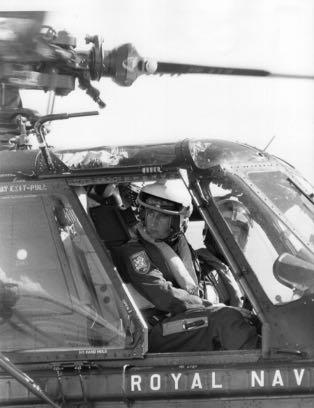
During my stint on 705 NAS as a QHI Culdrose held one of it's summer air days. The "star" attraction was the participation of the Prince of Wales flying his Wessex 5 in the flying display. 705 was chosen to host the Prince and his crew(s), and so he and the A1 QHI who was his "co-pilot" spent a few days with us.
On one of these days I was the Duty Instructor who manned the small cubby down stairs near the door and was (supposed) to sort out the usual chaos and make the flying program run smoothly. To my surprise Charles wandered into the room and started chatting. There was a quiet time in the program and so we had plenty to chat about.
What amazed me was the briefing he must have been given about the 2 Australian instructors on the squadron (Trevor Rieck was also on exchange). He knew about my USN training,
As he was not allowed to fly "solo", his "co-pilot" was an RN LCDR who was an A1 grade Instructor. Time has erased his name, but to say he gave Charles a hard time would be an understatement. As an example - a group of 705 instructors were gathered on the balcony overlooking the flight line when a display practice was about to start. The "co-pilot" turned to Charles and said something to the effect of "well laddie are you going to sit on your arse here or get the helo ready?" Charles duly headed down stairs and out to the aircraft. When passing below us, again from the instructor "well come on, give us the royal wave" to which Charles gave us all the middle finger.
Someone said "You are pretty hard on him aren't you?" To this day I remember the reply: "F**k him, I'm a passed over two and a half, he'll be promoted from Lieutenant to King"
From all accounts Charles was a pretty competent pilot.
Re the Caribou incident. I first arrived at Nowra in 1966 and at one stage the conversation at the bar came around to this incident. As told to me it went something like:-
Caribou pilot to ATC - (not verbatim) I will demonstrate a short landing in our shiny new STOL aircraft.
Short time later, loud noise and BooBoo sitting on the threshold of 26 with a broken wing spar and no serviceable landing gear.
Gannet pilot in the circuit (verbatim) That was f'n terrific, take it around and show us another one!
ATC - Gannet (side number) on landing, report to "Wings".
I guess our light blue brethren are touchy.
Love your new "Slipstream"
Cheers, John "Bomber" Brown (Mar25). ✈




Dear Editor,


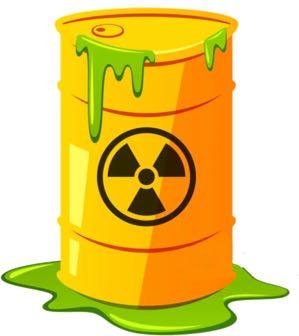
On arrival at HMAS Albatross after passing out of HMAS Nirimba in June 1972 after 3½ years doing our apprenticeship training, one of our initial tasks was to go to B hanger and strip the paint off of a S2E Tracker as a trialwhich some genius thought it would be an option to save the RAN money by not sending it to Hawker De Havilland at Bankstown Airport for a strip and repaint.
Well, we were dressed in an our Navy-issued blue overalls and only minimal SE gear. There were no safety warnings or protective clothing apart from goggles and rubber gloves. We were given plastic sheets news paper and masking tape and told to tape up all the Perspex windows etc with minimal supervision. We were then given multiple drums of yellow peril paint stripper, brooms and buckets, and with various ladders and stands told to cover the Tracker with this yellow peril paint stripper, and then hose it off.
Well, as the water washed off the yellow peril ,it also took off the plastic sheeting and masking tape and exposed all the perspex windows etc that were crazed and damaged by the yellow peril and damaged beyond repair. All the rubber door seals etc were also stuffed and there was total damage to all the leading edge de-icing boots on the wings and tail sections.
Apart from multiple injuries in eyes, faces and skin burns we completed the job, but never found out what happened to that Tracker - but as usual I think this trial was a failure as it was never repeated.
Years later found out this yellow peril paint stripper was found to be phenol based and carcinogenic and was removed from service.
Most of us from our intake are still alive but who knows what the future brings?
Regards to all
Kingsley Allard R105407
CPOATWL4
Ex S2E Trackers and Sea King Squadrons. Jan 1969 - Jan 1989. ✈

Have you thought about getting your name put on the FAA Wall of Service?
It’s a unique way to preserve the record of your Fleet Air Arm time in perpetuity, by means of a bronze plaque mounted on a custom-built wall just outside the FAA museum. The plaque has your name and brief details on it (see background of photo above).
There are over 1000 names on the Wall to date and, as far as we know, it is a unique facility unmatched anywhere else in the world. It is a really great way to have your service to Australia recorded.
It is easy to apply for a plaque and the cost is far less than the retail price of a similar plaque elsewhere. And, although it is not a Memorial Wall, you can also do it for a loved one to remember both them and their time in the Navy. Simply click here for all details, and for the application form.
Order No. 55 is open for applications. Names so far are:
L.M. Bateman Lt Cdr (P) 90972 Dec 52Jul 57
I.A. Oldham Lt Cdr (P) O7077 Jun 55 - Mar 57
D.E. Budsworth POATWL R62459 May 84 - May 76.
T. Marshall LSATC R66509 May 67 - Mar 79.

Australia needs to develop a new veteran affairs strategy. Failure to do so will worsen the Australian Defence Force’s recruiting crisis, increase separations from service, and grow cynicism from families and taxpayers about how government and Defence treats its people.
The Alliance of Defence Service Organisations(ADSO) comprises representatives from army, navy and air force associations, acting on behalf of all veterans and their families.
In preparation for the upcoming election, ADSO presented Labor and the Coalition, as well as minor parties and independent candidates, with22 yes-or-no questionsregarding veterans’ concerns.
ADSO’s pre-election policy submission details its recommendations for change. For example, the Alliance calls for the veterans’ minister to be made a permanent member of Cabinet. Currently, the portfolio sits with a junior minister who is left to argue for the funds to repair the bodies, minds and hearts of returned veterans and their families, all from outside the Cabinet room.
service pensions and health Gold Card benefits. The government should extend this to include veterans involved in dangerous peacekeeping operations in war zones around the globe, in designated Counter Terrorist and Special Recovery (CT/SR) operations, and in Rifle Company Butterworth operations during Malaysia’s 1968–89 counter-insurgency war. Twenty-two soldiers have been killed and hundreds injured on CT/SR operations alone, and more while peacekeeping.
There must be reform of the military justice system and legislative protection for veterans. For example, it may be time to consider Australia’s withdrawal from theRome Statuteand the jurisdiction of the International Criminal Court. Had the organisation existed during World War II, Australian airmen may have been liable to war crime charges over civilian casualties of aerial bombings in Germany. Australian law and Australian due process alone should govern our veterans.
The Office of the Special Investigator (OSI), announced in November 2020 and established in January 2021, should be given no more than two years from the election date to find credible evidence of war crimes and lay charges. If it is unable to do so, it should be wound up.
❝Financial support systems for veterans are awash with inequities and inadequacy❞
Financial support systems for veterans are awash with inequities and inadequacy. An independent judicial review of the military superannuation system is needed, as well as a separate review of compensation and rehabilitation entitlements for veterans and their families. Reservists should be entitled to the Veteran White Card, a governmentissued card that provides access to medical treatment, as well as discounts and concessions on medical costs.
At present, only service people who have served in certain declared overseas war zones qualify for
The OSIcost$57.14 million in 2021–22 and $63.3 million in 2022–23. In the 2023–24 budget, the office was allocated a further $129.4 million from the Defence budget. This scant taxpayer money could be spent on more important priorities, including veterans’ support needs. Further funding was allocated in the 2025 federal budget, bringing the total funding to around $300 million. It is not in the national interest for this expensive and damaging OSI process to go on indefinitely without results and closure.
Finally, Defence must fix its broken honours and awards system and produce an End of War list of Afghanistan veterans who were eligible or recommended for awards, or who had their awards downgraded, so that their awards can be reconsidered.
All is not lost. Minister for Veterans’ Affairs Matt Keogh, with bipartisan support, passed important veterans’ law reform designed to streamline the management of compensation and rehabilitation claims. The government provided funding to hire


hundreds of additional staff members for the Department of Veterans’ Affairs to deal with a massive backlog of claims. The Royal Commission into Defence and Veteran Suicide made important recommendations, which must now be funded and implemented. There is sound leadership and goodwill within Department of Veterans’Affairs, the Repatriation Commission and other branches of government to tackle these issues. But the incoming government must continue the effort postelection.
In August two ex-Navy aviators will depart on an epic 9,000 km flight to raise money for the Royal Flying Doctor Service. You can participate in this quest.
Together with former Navy/RAAF aviator Lyle Holt, I am participating in the Outback Air Race 2025 in our trusty steed and team namesake VH-CAF.
Australian families, potential recruits and serving personnel carefully consider the way the nation deals with its veterans when deciding whether to join or remain serving in the ADF. Without a modern, responsive, well-funded and dynamic veteran affairs strategy, our defence capability and our national resilience are weakened.
The Author. Martin Hamilton-Smith isa spokesperson for ADSO. He is aformer ADFofficer,is the nationalchairman of the SAS Association andwas South Australian minister forveterans’ affairs.
Image of poppies and the Roll of Honour at the Australian War Memorial:Rodney Braithwaite/ Department of Defence.
Source:This week on The Strategist. May 2025.

The significant challenge of the Outback Air Race - not to mention getting from Nowra to the race start in Yulara and back again from Carnarvon - will be made all the more worthwhile if you join us in spirit by donating. It only takes a minute to donate and any money you can give will go a long way to helping us reach our target. Please use the button or the QR code below.
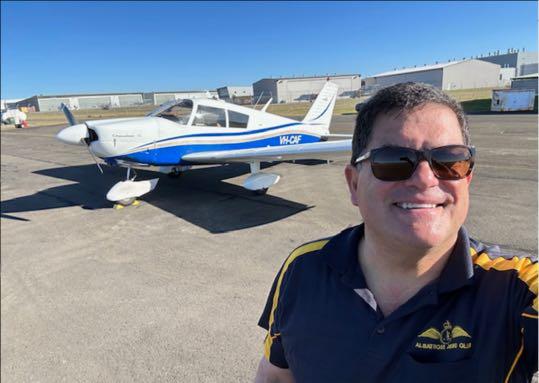

Thank you, we really appreciate your support for Team Charlie Alpha Foxtrot. Vince Di Pietro. ✈
John Macartney’s planning for the 2025 Old Bar Reunion is well advanced and you are invited to register your interest in attending.
The reunion will be held at Old Bar over the period 16-18 August, and will include social meals and gatherings as well as a Vietnam Veterans Parade and Memorial Service. Full details can be seen on the flyer which Mac has provided, which you can find here Any questions can be directed to Mac here
Mac (Right) with Phil Harris, Principal of the Old Bar Public School who will be hosting the Service.

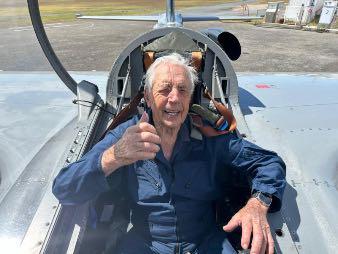

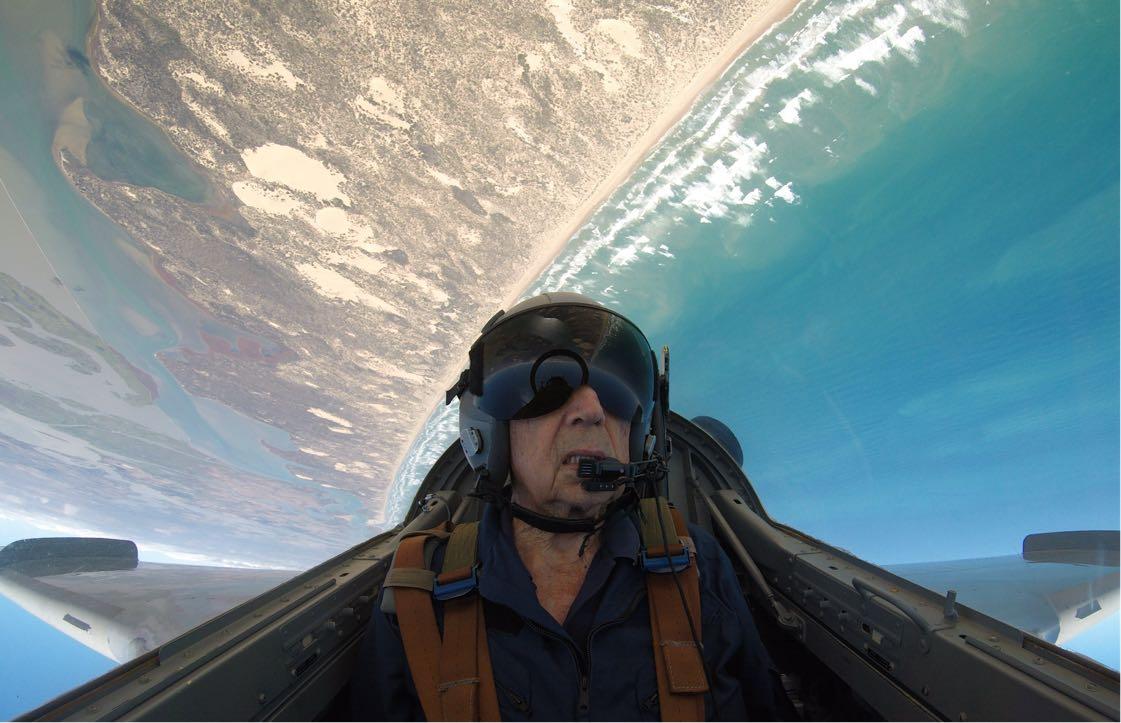
How would you like to celebrate your 101st birthday? Well, if you are of the same mind as Henry Young OAM, you’ll fancy an aerobatic spell in a S211 jet trainer.
John Siebert, the President of Henry’s Division of SA reports: “I was pottering around in our hangar at Goolwa when I heard on the CTAF radio frequency a conversation between two pilots joining up for some formation flying. I recognised the voice of our local retired test pilot

Jim Whalley in his S211 jet trainer as he called to the other pilot in a helicopter saying:"Hold this steady heading... I'm flying with a rated Seafire and Sea Fury pilot"
There is only one person I know that held those qualifications so after the S211 landed I went up to the refuelling bowser. Sure enough our member Henry Young was emerging from the instructor’s seat with a broad grin. His son had given him a birthday present of an aerobatic flight with Jim.
Jim remarked that Henry had flown the aeros "like a champ." Henry's comment was "Its like riding a bike - you never forget'.✈
Top Insets. Henry Young of SA Division after his flight in an S211 jet trainer, a present from his son for his 101st birthday in April, and below, Jim Whalley’s Marchetti S211 jet trainer.
Left and Below. Unsurprisingly, Henry has become a bit of a legend in his part of the world. ✈
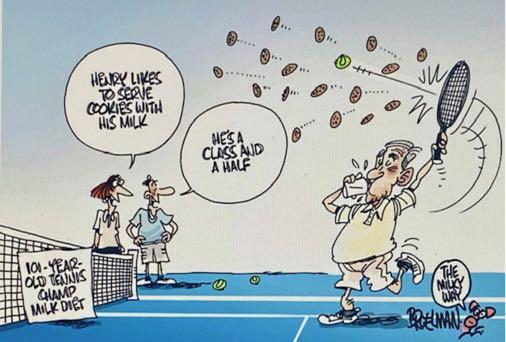

by Eric Manuel

consumed in copious quantities. Two inseparables drank quadruple gins and rums respectively at lunch time. A glass of water was substituted for the gin one day, it was duly quaffed, straight down, and the recipient was sick. A great time was had by all!
At that time the Aberdeen and Commonwealth Line was in existence. Included on its books were the three sister ships, Moretay, Largs and Jervis Bay. Having had previous experience on the Largs Bay (transit of MONAS 9 from Sydney to Singapore) some of us were forewarned. We are still amazed that only the Jervis Bay sank, the remaining two were rust buckets with buccaneers for crew. During the trip we took on migrants from various Mediterranean Ports. Their hygiene left a lot to be desired - to them a passageway was a toilet at night. I could write a book on that trip, but then, I digress.
We eventually arrived in Sydney and were herded into a set of 'cattle trucks' masquerading as carriages, drawn by a wood burning steam engine. It was hot and steamy in the train and the windows had to remain closed to stop lumps of cinder and smoke blowing in.
We eventually arrived in Bomaderry and offloaded into vehicles for the trip to Nowra. Arrival was in the dark, but what was this? Sheets issued ! It was never like this in the RN.
Morning came, awakened by bull frogs, lizards, and that 'little old man' laughing his bloody head off. How was I to know it was a bird? I've always been at a loss as to why 'Sussex by the Sea' was played. Was it the only record available?
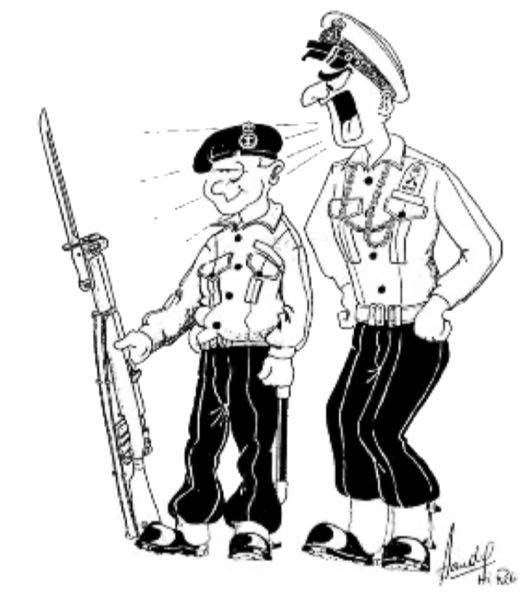



Above. The author (left) and Sgt Barry Gordon RAR outside Nirimba’s canteen after a ‘Sod’s Opera’in 1953. Below. Sister ship to the famous SS Jarvis Bay, Largs Bay survived the war and was subsequently used to transport immigrants to Australia.✈
Several weeks were spent carrying out various jobs at Nowra, but there seemed to be no rhyme or reason for our presence. I worked for a while on a glider for a WO named Kent. When it was completed he flew it for a while but on landing one day, the hangar moved and he had a head-on collision with it. I'm told his shoes didn't fit afterwards.
A request for instructors was posted on a notice board somewhere in Albatross, I can't remember where. Having completed an Instructional Technique course and a stint as an instructor at HMS Gamecock, Bramcote UK (the WRENS only had HMS on their tally bands), I volunteered. This was my second mortal sin, I had volunteered twice in a year - never done in 'Pussers' . We were herded once more on to the Sooty's train and were transported to yet another flyridden outpost of the Commonwealth [Schofields] or was it Empire? Was it not known as Albatross 2? The RAAF were still in occupation in certain areas, but were only a reserve unit. The main squadron was 22 Squadron City of Sydney (Mustangs) which flew, if ever, on weekends.

Above. The layout of Nirimba changed little from 1942 to 1970. The lighter coloured buildings are mainly amenities. Post 1990 new brick accommodation, admin and other amenities were built as part of the SAILSTRUC regime. They are not shown here.
Click on the button to watch video about Nirimba.✈

The hangars were also used to house two Bristol Sycamore helicopters, which were being modified by civilians prior to the visit of the Queen and Prince Phillip, but if I remember correctly, they never used them. One was flown by an Air Commodore, unfortunately he made contact between the rotor and the hangar wall - and then there was one. He made his way to the crew room and made an entry in the A700: one used quite often - 'Pilot Error'.
As I remember it, the first classes of mechs spent their time erecting partitions for classrooms in the hangars: A's and E's in one and the remainder in the other. Privacy was never part of instruction in the hangar - a trainee could hear two or three instructors at any one time and learned the whys and wherefores of Centaurus, Firefly Hydraulics and Theory of Flight all in one lesson. Aircraft being ground run at the Stop Butts to the rear of the hangar didn't help either. How anyone learned enough to pass exams always amazed me. Maybe the instructors fiddled the results - after all, they didn't want to prove themselves incompetent!
Various trainees were instructed: Air Mechanics, Mechanicians, Pilot’s Mates, and the bane of all instructors, the 'Nashos'! These were a group of National Servicemen brought in for - was it nine weeks or nine months? They were mollycoddled and treated with kid gloves. Regulars were screamed at by the Duty Chief at reveille, but the 'nashos' were requested to leave their beds from
the doorway! Ludicrous? Of course. Trainees’ cars were left outside the main gate while the 'nashos ' drove into the camp and parked alongside huts and hangars .
One such person was a member of the Amott Biscuit family. The parking of his new Fiat alongside the instructor's ratty vehicles tended to be incongruous to say the least. I owned a 1936 Ford VB, purchased for about three hundred pounds on-time payment - oh, to have it now!
The cars driven at that time would have been worth thousands today. Vehicles that come to memory included a 1935 Ford VB (Truscott ), a 1936 Ford 10 (Galliott), a 1925 Morris 25 (Jones) and a 1926 Crossley (?), there were many more including the snob value of a 1948/9 Holden owned by a gentleman named Jones.
A 1925 Morris Cowley (square radiator), was owned by an equally vintage character irreverently known as 'Barney Bear' by the trainees, due to his gait and bulky form. I personally knew him as 'Herr Funkel Dunkel', mainly due to his attitude towards me. I'm sure that anyone at Nirimba will remember the Lt Cdr TTO to whom l refer. His technical ability was second to none, especially in the repair of his shoes. Imagine walking into a workshop after having instructed a class on Workshop Practice to never grind soft materials on a grindstone, to see a TTO grinding the heels of his shoes after repairing them with MASONITE!
The crankshaft broke in the Morris Cowley, and it was duly repaired by setting it up in a lathe and pinning and welding it. The mechanic that carried out the work would have had to be a genius! The engine was replaced in the car and I was commissioned to tow start it. The driver of the Cowley, intent on keeping the engine running, failed to stop and consequently jammed the front end under the back of my car. I jumped on the front end of his car and the whole lot fell in a heap! He politely told me that I was a bloody fool and walked off in a rage. His car is probably still therewho knows?
One day the establishment was granted a 'make and mend'. As was always the case, instructors and staff migrated to the Mess to partake of the amber fluid. I had promised to replace wooden running boards on an Austin 8 owned by a Lt. Smith. I was in the process of carrying out this job of love when who should present himself at the workshop door but my favourite 'Herr Funke! Dunkel', (who, incidentally, wrote children's books) .
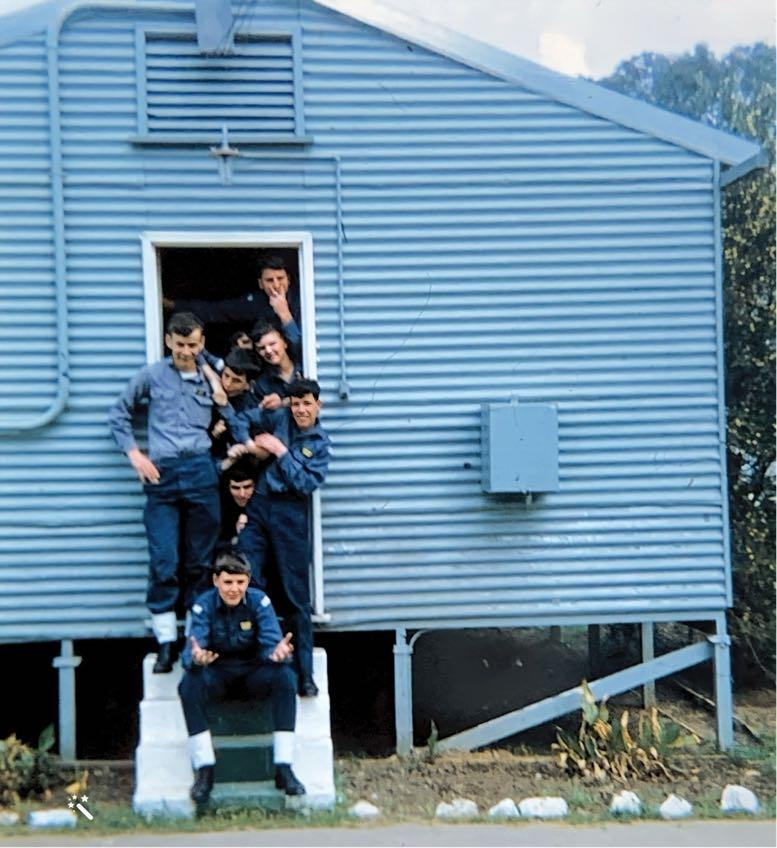
He very impolitely asked me what I was doing and I politely told him. He immediately shot through to the Chief and PO's Mess to find the Chief Instructor, Pat Barry. After telling him of my misdemeanour and directing that I should be charged, he was duly sat on the bar and told to 'Sing, sing, or show your ring', a most humiliating experience for the poor man, but he stridently performed 'Pretty Polly Perkins of Paddington Green '
I was eventually charged with I know not what, and received a weeks stoppage of leave from a very understanding Commander who had the initials of a well known liquor [VAT]. I have to admit, I noted his inferred advice and after my evening reporting I drove home to my wife and children. The galling thing about the whole episode was that Lt. Smith denied asking me to do the job. I've been told that he drowned in the Hawkesbury river whilst water skiing shortly afterwards.
The Chief and PO's Mess was a den of iniquity and a popular watering hole for a variety of
Above. Anyone who served at Nirimba would remember this, although it looks like this donga had a paint job, probably post 1960up to then they were still sporting the old RAAF livery.
It’s probably fair to say that of all RAN establishments, Nirimba generated the most enduring mateship and espirit de corps by those who learned their trade there.✈
people after 6pm, which was closing time for the local pubs (5 o'clock slush). One group that was in constant attendance was the Blacktown and Parramatta Constabulary. They were not renowned for their sobriety. Whilst Duty Chief one night, I saw police carrying a person to a small car. When I suggested that he shouldn't drive, I was politely told to mind my own business. The Guardroom was instructed to remove him from his car and place him in the cells. Ten minutes or so later, I was called to the 'phone and a plaintive voice advised that the person in the cells had smashed a bed and was breaking out through the wooden walls: 'what will we do?' they asked. What else but to put him in another cell where he stayed until sober and thence home he went.
The next morning I was called to the Guardroom to meet a Police Sergeant. Instead of planting one on me, he offered me his hand and thanked me. We remained friends 'til my return to the UK. I understand that he has since passed on to that cell block in the sky.
Sex had to rear its ugly head at Nirimba. All had to know 'Trigger', the friendly female. I had no personal experience with the lady except when she showered next to me one time. I'm told that her nickname was acquired because she never went off half-cocked, but not being a gunner I don't understand the expression. Her two daughters were also quite friendly with the apprentices.
Night rounds could be enlightening. Passing an open door in which a Mechanician (A/PO) was billeted, Trigger's voice was heard to say, "You're married!' 'How do you know?' was the response. 'Because only married men do that," was the answer. I've often wondered!
Two young girls took up residence in the old Married Quarters on a mattress unwittingly supplied by the Defence Department. During rounds, trainees were found lining up for 16 bob a time. The girls were banished over the back fence and took off to hitch hike to Blacktown. They were picked up by Cdr(S) who was going their way and, yes, they even offered him a bit of slap and tickle, at a price!
The disused Married Quarters were eventually demolished but it was not known if this was done officially, because if some of the older houses in the area were given the order, 'all Married Quarters parts fall out', they would have fallen to pieces. One PO who will remain anonymous was seen carrying a bath through the back fence, on his pushbike!
Various pets were held on the camp, one of the most popular being a bitch called 'Minge', an appropriate name if ever there was one. She produced more pups than you could throw sticks at of all colours: black, white, brown and brindle. A friendly local lady made a present of a British Bulldog as a mascot. He had his own Naval Airman handler and a special enclosure near the main gate. Advice was given that he would be more of a dog after his first service. Poor old Minge was up for it again.
There were lesser known pets, one PO was seen in the Mess at lunchtime talking to a frillnecked lizard tied to a chair leg with a strand of copper wire. When he had a mouthful of beer his pets open mouth couldn’t miss out. One day whilst on the way to the hangar he was asked the whereabouts of his lizard. “Got rid of him,” he said, “he was a drunken bastard.”
During 1953 a group of trainees sectioned a
Did you know that the word “Nirimba” is a Dharug word for ‘Pelican’- hence the bird in the ship’s crest.
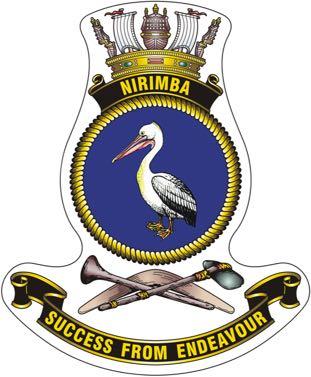
Rolls Royce Griffon engine and made a really good job of it. It was displayed in the Services tent at the Easter Show in Sydney. I spent the whole period with it and the questions asked were many and varied. 'Is it an Ack Ack gun?' 'Do you know that the piston stops at the end of its stroke?' Anyone with technical questions invariably arrived when I was about to take stand easy. The engine is, I feel sure, the one now on show at the Museum. It is painted in garish colours and is an insult to its original fitters.
Entertainment was varied, both in the theatre and
The RAN Repair Yard Schofields was commissioned as HMAS Nirimba on 01st April 1953 as a joint Aircraft Repair Yard and technical training establishment. The Aircraft Repair Yard of the partnership was short lived, however, being closed down in early 1955. The establishment became a fully-fledged Apprentice Training Establishment in 1956 - a role it continued until it closed its doors on 25 February 1994. In those 29 years it trained over 13,000 young men and women from the RAN and other Navies.
The site has since been redeveloped as the Nirimba Education precinct and includes facilities such as The Western Sydney University, the Western Sydney Institute and Wyndham College. It also embraces the new suburb of Nirimba Fields.
in the various Messes with ‘Sods Operas’ and local concert parties. The Chief and PO’s Mess was renowned (parochially) for its motor cycle track around and over the billiard table. One brave soul rode his landlady’s auto cycle though the fibro wall separating the table tennis and billiard areas and thought it was hilarious.
Visiting concert parties had a varied content of participants. One party that comes to mind was well known for its three main characters - a portly and rather raucous middle aged lady; a young woman rather well endowed in the mammary department (she was an actress - her act was to fall over and then attempt to stand up without assistance). The third was a rather limp-wristed blonde haired male who insisted on singing 'Row, Row, Row' - a song for females - or was it 'Roll, Roll Roll'?
Being duty on the night of a concert, I was the bunny delegated to return the above crew to their various abodes. Two A /PO's, renowned for their sexual prowess, insisted on accompanying us. The young female was first out of the car, duly accompanied by one of the PO reprobates. The 'boy' was left in the car with the other PO in the back seat whilst we walked the 'lady' to her house. I returned to find the car empty!
The following morning the other PO was displaying his back which was mutilated with scratch marks “caused by a cat that crept into his bed” he said. The other party didn’t return and could still be ‘Roll Roll Rolling’ along for all I know.
I could go on and on but I feel that the defamation laws could rear their ugly head.
The first sighting on posting in, and the last in the rear-view mirror when you graduated. HMAS Nirimba 1953-1994
We returned to the RN in dribs and drabs, others remained to serve further time with the RAN. Each individual embarkation and return to the UK was an emotional experience. One that I will always remember was that of a well known veteran in the Senior Sailors Mess, Jack Kitney. He was onboard, standing in the crowd of passengers, the ship festooned with streamers and ladies’ stockings, when one of our group shouted “Sing us a song, Jock!”. His favourite at the time was ‘Those wedding bells are breaking up that old gang of mine’ It soon developed into an emotional event when the thousands on the wharf started singing. Jack would probably not remember it, and anyone who remembers him would know why!
I returned to the UK with my family, one more than when we arrived, this time on the Orcades I finished my twelve years with the RN and, after eighteen months of terrible weather, returned to Australia on the Strathaird as a 'ten-pound Pom.'
On arrival I applied for a position as an instructor at Nirimba, but after meeting with the TIO, I changed my mind and went to work for an Oil Company instead.
I think I'll stay this time.
Cheers, Eric Manuel UFX 87575.
Footnote. There was obviously no love lost for Technical Training Officers. Eric also forwarded this definition of a TTO: 'They can tell you the square root of the circumference of a pickle jar to three decimal places - but then can't get the ✈


By Sailor Sam

To discover that ‘Johnnies’ is now a heritagelisted building is a surprise. Officially known as Royal Naval House, it was located at 32 Grosvenor Street, Sydney, serving as a recreation and accommodation centre for Navy people from 1890 to 1970.
Heritage NSW lists the cultural and historic significance of Royal Naval House, its proximity to the ‘Rocks’ area, and Victorian-era architecture. On 25 June 1889, when Lady Carrington laid the foundation stone, Premier Sir Henry Parkes said, “The Navy’s role in protecting our nation and shipping lanes is vital, and the completion of this building ‘is of the highest importance’”,
Royal Naval House replaced a smaller home for sailors established in 1876. The need for a larger place for men on leave was urgent due to the growing presence of HM Ships in Sydney Harbour. In 1890 Lord Carrington officially opened the house which soon became known as Johnnies after John Shearston, its first superintendent. In 1907 a new wing was added to meet demand which continued over the years.
During WW2 (1939-45) Royal Naval House accommodated hundreds of men each night especially after the arrival of the RN Pacific Fleet, also small ships were billeted there. In 1946, a record number of 307,678 sailors were housed. In the 1960s, when demand was reduced, naval families could book temporary accommodation until the building closed in 1970. The Sydney Cove Redevelopment Authority then took over and after redevelopment it became home to the Sydney Futures Exchange. Johnnies was run by a friendly crew, generally
kindhearted old timers who looked like Methuselah. But there were rules, and everyone was expected to toe the line. In the general sense it ran along navy lines. Apart from providing a bed it was a refuge especially for those who were strangers to Sydney, and a convenient place to meet up with your mates and try to keep out of trouble.
The front desk issued bed tickets and offered a cloakroom and a safe deposit service, a notice board, and a post restante for wandering sailors. If you had a Commonwealth Savings Bank account passbook you could draw out money almost anytime day or night – a lifeline in the days before credit cards and ATMs. The dining room served grills and in the evening most likely a roast – usually served by nice ladies who reminded you of Mum.
The dormitories were fairly Dickensian, basic and crowded. But it was a place to put your head down and the steaming hot showers were a delight after weeks at sea. One unforgettable feature was the morning ‘gong’ – capable of waking the dead – used to rouse sailors sleeping late. It was large round silver tray, with a piece of wire for a handle. At the appointed hour, an old janitor would arrive at the dormitory door saying ‘get out of bed you bastards’ while beating the gong.
I’ve lost count of the number of times I stayed at Johnnies. It was very basic, but it was clean and a place to come back to when you needed it. And central to all that a great city like Sydney could offer – which is was a lot. Royal Naval House was remarkable in many respects. A major feature of the building, typical of the era, was a large central
light well with balconies around each floor. At the bottom of this quadrangle, as viewed from above, was a basement called ‘The Snake Pit.’ In this spacious, white-tiled area was a wetcanteen bar which provided what can only be described as a brewery-owners dream.
In those days pubs would close 6-7 pm then reopen until 10 pm, they were also shut on Sundays, but you could get a beer at Johnnies. On weekends, the wet canteen would be crowded wall-to-wall with sailors all drinking like there’s no tomorrow and roaring like bulls. As an naive 17-year-old O.D. on my first visit to Sydney, I was truly astonished at what appeared to be something akin to Valhalla. The clientele was interesting too. In the late 1950s it consisted largely of crusty seadog types, that-is sailors in their late thirties and early forties, most often three-badge A.B.s. As one bright spark explained they were happy where they were and not ambitions. All they wanted was their own wash-deck lock and to be left alone – but could spin great stories about their adventures.

family so to speak and that ipso facto the Navy had become their adopted family. At Christmas time or whenever they took their annual leave these, solitary, silent, lonely men would stay at Johnnies. Some of the lucky ones would find a sweetheart and have a place to go to. But for many Johnnies was the place where they stayed.
Sadly, these people were to be weeded-out during the early 1960s when the boffins decided the Navy must have career-minded people willing to move up the ranks. It was about this time that ‘work-study’ teams would visit ships and depots to ensure efficiency and identify ‘improvements.’ This included getting rid of some of these older sailors – many of whom had seen active service at a young age. Yet, often as not they were the ones who knew their ship backwards, what needed to be done, and how to run the machinery properly. Also, among them were artists at splicing heavy cables and doing fancy rope work.
I should like to share a little understood role Johnnies played over the years – which relates to some of the sailors above. It is not generally known that a surprising number of sailors (at least in my time) came from broken homes, often their fathers had been killed in the war and had spent their childhood at an orphanage, or when their mother remarried they didn’t get on with their stepfather. And quite a few came to Australia from the UK under the Barnardo’s scheme having suffered shattered lives. Some were estranged from their families or only knew of distant relatives or siblings they had never met. The result was that many of these sailors had no
I have to confess I remember Johnnies well, because one evening after checking my bunk on an upper floor, I noticed a sign saying, ‘Reading Room.’ Curious, this led me to a part of the building I never realised was there, and obviously nobody else did as the room was empty and was in darkness, except for the twilight and the glimmer of stars through a large window which overlooked a laneway.
It was only after a while standing at the window admiring the encroaching darkness that my eye was attracted by a sudden burst of light from a window below on the opposite side of the lane. The window was in fact a hotel bathroom with wrinkle glass on the lower panes and clear glass in the upper panes through which I saw a young lady enter the bathroom and cast aside her robe to reveal one of God’s wondrous creations of great beauty.
I hasten to add that I quickly took custody of my eyes and averted my gaze. But I soon overcame this urge in time to see her reach over and turn on the taps to fill the bath, then knot her hair above her head. Unfortunately, by now the windows had begun to fog up which ended this vision of loveliness. But grateful for the memory, I now call this my ‘twilight experience’ as in my twilight years it helps keep my spirits up and remains one of the enduring memories of Royal Naval House, Sydney. ✈
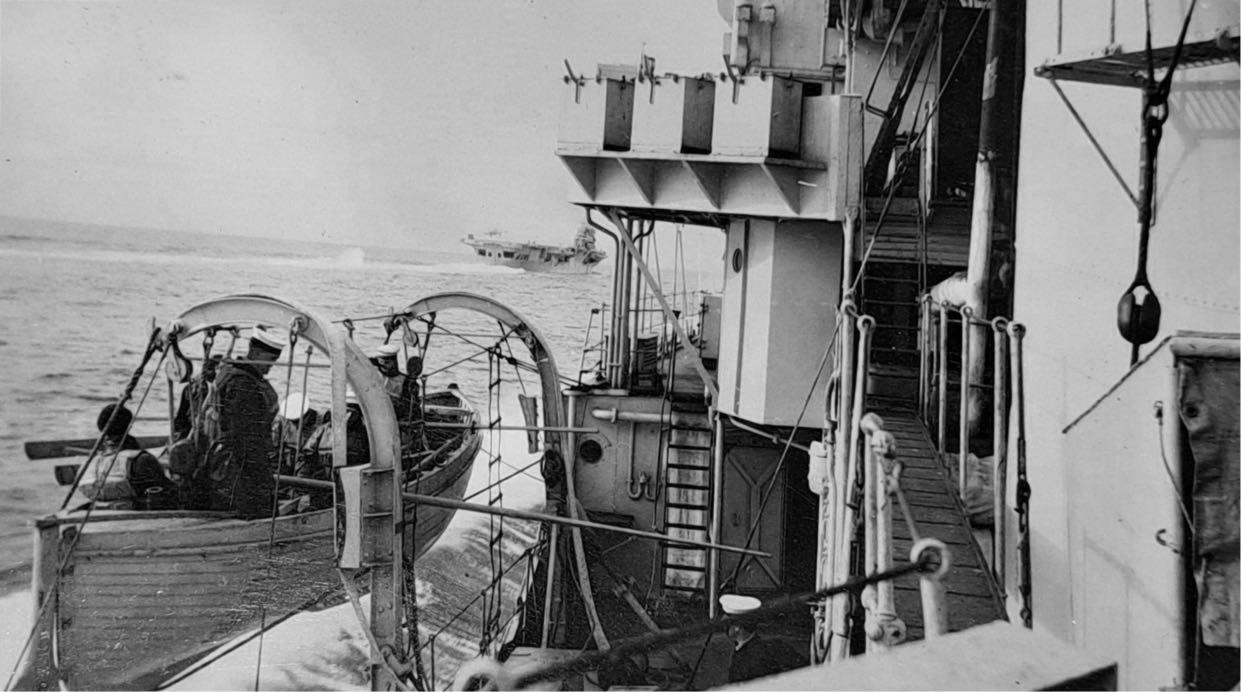
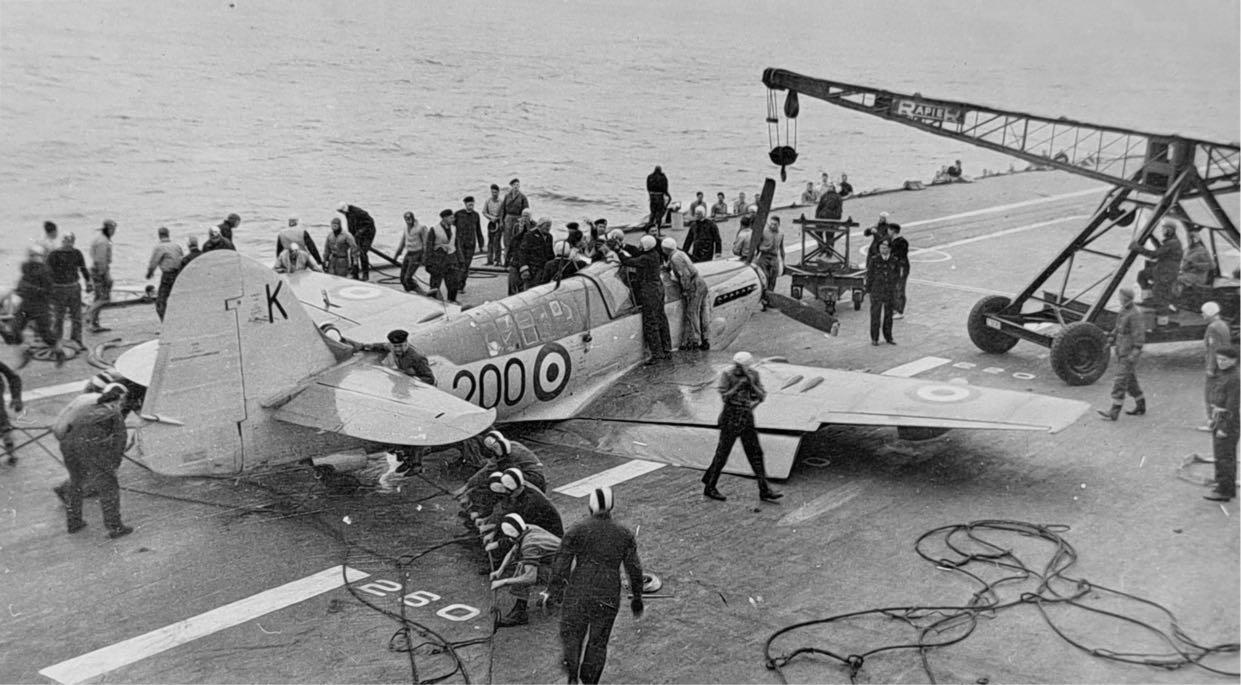

Every now and again we get a little pot of Treasure sent our way. This time it was a collection of 130 photos, taken in the early 50s and 60s of time aboard HMAS Sydney and some of her destinations. Its not clear who the collection belonged to, but captions on the back of some of them suggest it could have been NAM(O) Brian Worthington R36195 (pictured right), who served in the RAN from May 1948 to mid 1960. Brian did a number of stints aboard Sydney as part of the 20th CAG. Can anyone remember him? We’d like to know if he was the owner of the collection and any advice about his hobbies etc would be welcome. Click here. ✈







On the 3rd of October 1952, at 0930 hrs, (WST), the River class Frigate K271 HMS Plym exploded on a largely unknown archipelago, the Monte Bello Islands. The Islands are located off the Pilbara Coast, 120km west of Dampier and 139km north of Onslow in Western Australia. HMS Plym was a long way from home.
Plyms last journey began from Chatham Kent, stopped in Sheerness to take on her special cargo and from there to Gibraltar, Freetown, Simonstown, Mauritius and then to Perth, Western Australia. Monte Bello was the next and last stop. The ship anchored off Trimouille Island, using six blocks of concrete in addition to her anchors, in an effort to keep the ship from making any unnecessary movements. Her special cargo was an atomic bomb.
Dubbed Operation Hurricane, this was the first British test of an atomic bomb on Australian soil and its design was similar to the American “Fat Man” used in World War II. The bomb’s radioactive components were flown from RAF Lyneham through Singapore, in various aircraft, with the scientists completing the construction on site. It was hoped that his first test would garner data relating to future food storage, shipping, structures, marine life and the shifting of radioactive dust particles, both in the air on the ground. [1]


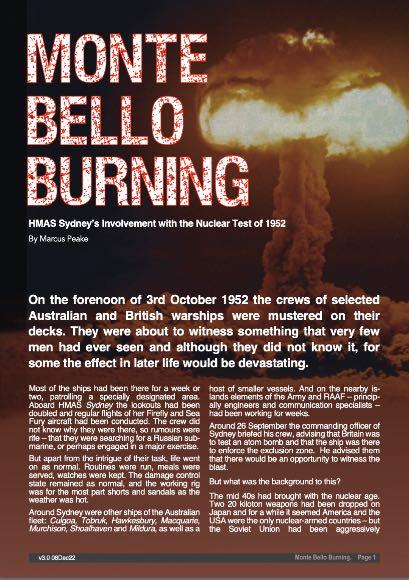

Above. Members of the WA Division gather with the two Montebello veterans on the occasion of their award of their Nuclear Test Medals. Back (L-R) Keith Taylor, Ross Sarti, Samantha Patuto (DVA Assistant Commissioner), Brett Dowsing, Bill Atthowe, Greg Kelson, Paul Hodgkinson. Front (L-R) Dennis Nixon, President Mike Keogh, Harry Webster, Marie Rennie (British Consul General), John Weller, Mick Spahn and Steve Akerman. Right: The Brit Nuclear Test Medal.

The explosion vaporised Plym and left her impression on the seabed. A lasting impression was also made on those seamen who witnessed the blast. Among the many British and Australian ships playing the role of observer, was the aircraft carrier HMAS Sydney with Harry Webster and John Weller aboard.
Harry had joined the RAN in August 1945 and served in the supply branch the 20th Mine Sweeping Flotilla until joining the fledgling Fleet Air Arm in 1947, with the idea that anything would be better than risking life and limb detonating mines. Harry was aboard Sydney, as part of the 20th Carrier Air Group, when she sailed to Sydney to become part of the RAN. In August 1952 Harry was standing on the flight deck, in shorts and sandals, with his back to the explosion. Harry’s recollection? “The explosion, as once seen, would never be forgotten”.
John, standing with Harry on the ship’s flight deck, was an Aircraft Handler who had joined the FAA in

October 1950, and served on the carrier from April 1952. John remembers: “standing on the flight deck and seeing the explosion, then 3-4 seconds later HMAS Sydney shook, and the massive cloud rose up from the impact point”.
Harry Webster (97) and John Weller (93) have received their Nuclear Test King Charles III medals, which provides recognition for their participation in nuclear testing in Australia. The British Consul General Maria Rennie and DVA Assistant Commissioner Samantha Patuto, joined other members of the W.A. Division to congratulate Harry and John on Friday May 16, 2025.
You could say that we are all witnesses to history, but for Harry and John, these words refer to something unique, something we all hope to never see.
Harry and John, we thank you for your service. [1] The First Atomic Bomb Test on Montebello Islands. www.naa.gov.au>defence-equipment-and -weapons.





Sea Fury WH537 was struck off charge from the RAN in September 1963 and sold to a Sydney-based buyer, but was shipped to the United States the following year. She was eventually acquired by airline pilot and engineer Ellsworth Hovey Getchell (“Gretch”), who had an enduring love of the type. He restored, maintained and operated WH587 for over 45 years until his death in 2020. The aircraft remains in his Foundation which is dedicated to its ongoing maintenance and operation.
The Editor of Slipstream received a letter in June 2025, advising that WH587 is currently being returned to flight status after a long period of maintenance. Its great to see the old girl still has a life. ✈

Following recent tariff tensions with America, the Canadians have decided to show what their side of Mt Rushmore looks like, giving an insight into their view of the statesmen depicted there. Says it all, really...

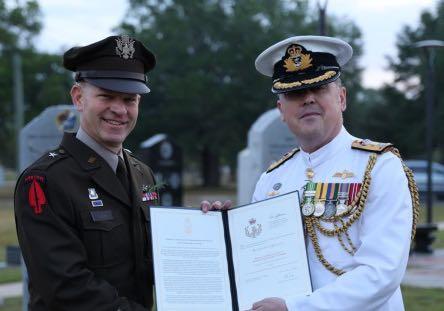

We know it’s June now and ANZAC Day was a while ago, but thought this might be of interest. It’s a photo of CDRE David Frost (the previous COMFAA), presenting the HFV Unit Citation for Gallantry to one of three American members of the 135th EMUs present on the day. The ceremony occurred at Fort Novosel in the US, which held a Dawn Service to commemorate the bravery and camaraderie of ANZAC forces who fought alongside the United States.
The Unit Citation was given to HFV veterans in 2008 and was extended to their US Army counterparts in 2019. ✈
from the Editor
John Travolta’s classic Boeing 707 jet is on the way to the Historic Aircraft Restoration Society (HARS) where it will have pride of place as a static display.
Travolta purchased the B707 from Qantas in 1998 and had some fun converting its interior to a luxury mansion with two bedrooms, dining area, entertainment room and galley with silverware and tableware for 34 guests. In a canny deal with Qantas he then secured an advertising contract which paid for the aircraft’s upkeep in return for him becoming “brand ambassador”. The aircraft was painted in Qantas livery and a very successful partnership ensued.

He gifted the aircraft to HARS some years ago and the intent was to fly it back to Oz, but airworthiness issues were ultimately too great and it is being shipped to Albion Park in pieces. The first parts arrived in Sydney in May and others will follow as time and money permits. You can help with a donation here ✈


The RNZN is to get new helicopters to replace the Sea Sprites they bought from us at a bargain basement price back in 2015, following our own disastrous project to acquire them. (Read “Billion Dollar Blunder” here).
The plan is to purchase five new helicopters, although the type and delivery date is yet to be announced. Contenders are likely to be the Naval Frigate Helicopter (NFH) to go with their existing MRH90s; Seahawks to achieve some commonality with the RAN, or perhaps the Augusta AW159 Wildcat, which is an improved version of the Westland Lynx.
Defence has been a very low priority for successive NZ governments and the acquisition raises ongoing questions about the balance, size and viability of the NZ Defence Force generally. ✈
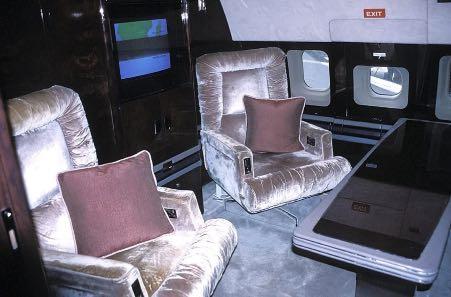
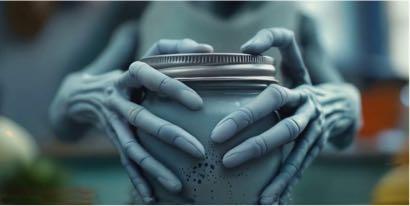
Peter Weyling, who was a graduate of the RAN Apprentice Training Establishment (HMAS Nirimba), has passed on this useful tip for those of us who still tinker mechanically.
You don’t need to buy a torque wrench. Just listen for clicks in your joints as follows:
50 ft/lbs - wrist
100 ft/lbs - elbow
140 ft/lbs - shoulder
175 ft/lbs - knee
225 ft/lbs - hip.
For relative youngsters, you might want to convert the above to NewtonMetres, whatever the hell they are.
I’m told one ft/lb = 1.35582 Nm.
It’s also a measure of masculinity. If you are getting 67.79 Nm out of your wrist, you are not limp-wristed!
Any other money-saving tips gratefully received...
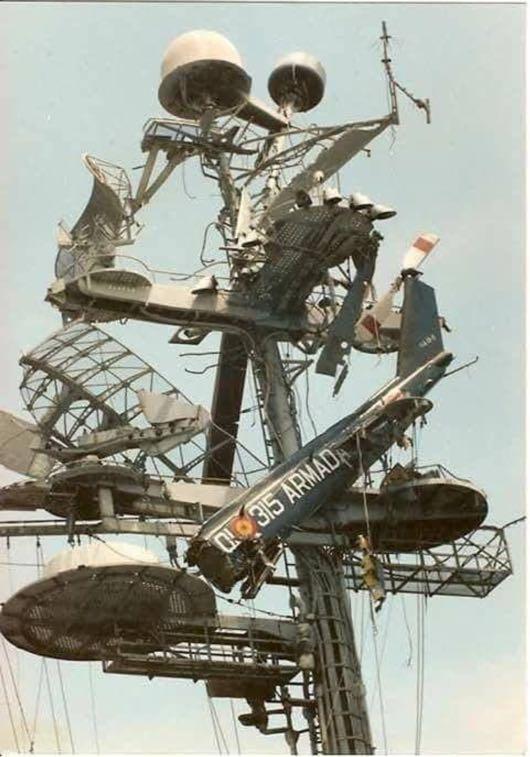

We all know that aviation is risky, but this accident demonstrates even the most unlikely events can happen. It was a Spanish Navy Augusta Bell AB212, registration HA.18-11, which was conducting night flying around the Spanish carrier ‘Dédalo’ (formerly USS Cabot) in May of 1986 when it collided with her mast at about 0100. Unfortunately the crew of four perished. Media reports at the time identified the aircraft as a Cobra, which it was not. ✈
Albatross is always busy fielding visitors of one kind or another, but they particularly enjoyed hosting the PNG Minister for Defence, the Hon Billy Joseph PhD MP and PNG Secretary of Defence, Mr Hari Akipe on a recent visit. The images right show a demonstration of the Helicopter Underwater Escape Trainer (top) and (lower) the Minister in the EC135 simulator. (Material courtesy of NSW Division). ✈


Boeing has shelved plans to build and fly the experimental X-66 project aircraft, which it was working on in conjunction with NASA.
The concept was to test new airframe technology for the next generation of singleaisle airlines: specifically, the ‘long thin wing’, which teased at significant savings in parasite drag and therefore increased fuel efficiency.
Perhaps it is a further sign that the embattled aviation company, already reeling from its disastrous 737 Max debacle, quality control issues and, more recently the effects of Trump’s tariffs, is in dire straits. More conservative analysts are forecasting these problems, together with growing anti-American sentiment around the world, could spell the end of Boeing. We shall see. ✈





from the Editor
Losing an F22 at the best of times is an expensive and unfortunate occurrence, but when it ‘fell overboard’ during a routine deck move it is especially galling. We had a similar loss when an A4 went over the side in rough weather in September 1979.
At the time of going to press no further details were available, other than it incident happened on 28 April in the Red Sea, and that it occurred from the hangar deck whilst the ship was performing ‘an evasive manoeuvre’ that sent the Super Hornet sliding off the deck, together with its tow tractor.
The photo above shows how close to the edge of the elevator the jets are positioned. Not surprisingly there are a host of procedures and regulations laid down about moving aircraft, including one which states: “Elevators shall not be operated while the ship is in a turn heeling towards the side on which the elevator is located...” It doesn’t say anything about positioning aircraft on the lift though.
There is also the consideration of ‘tipback’, which is the angle at which, when balancing on the main gear, the tail will hit the deck - with the risk of the aircraft toppling into the sea if it is close to the deck edge. For a super hornet this is about 19° on level ground, but is dependent on the loading on the main gear, the centre of gravity of the aircraft and any inertia applied to it rearwards. Ship movement would not help either. ✈

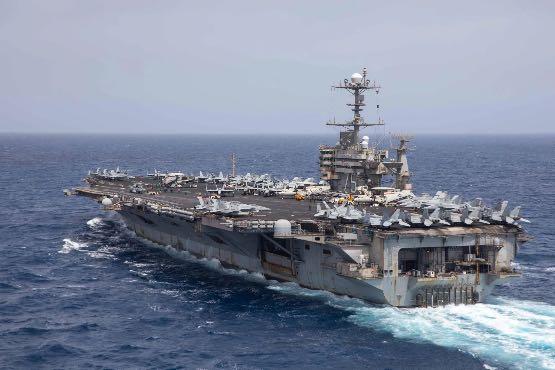


Where has this year vanished to? How is it possible to be midyear already and Autumn has crept in with all my library books overdue? When did I get so faded and wrinkly? Why is everyone whispering? And why is my incontinence pad so uncomfortable? Questions with no answers I am sincerely informed.
by Roger Harrison

worked through the routine of forming a working committee and he has succeeded without too many surprises. The State President remains John Siebert, Vice President Gerry Dowling, Secretary Roger Harrison, Treasurer is Ian McBeath and Committee Members are Brian Thompson, Vic Byers, David Smillie and bSorted.

A warm welcome to 3 new Members to the SA Division although Fred Driver is a returned Member. The new members are is WOATWL Eric Edwards and Mr Glen Battye.
The March AGM was a slick affair where the President
ANZAC Day has come and gone along with the Federal Elections on May 3rd. ANZAC Day in Adelaide, started with our Henry Young laying the FAAA wreath at the Dawn Service on North Terrace, and the ABC gave him some

footage after his wreath laying, possibly more by accident than design. Followed later by the Commemorative March and Service from 0930. I remember changing step at least ten times to keep in step with John Siebert leading the Division who also struggled keeping in step along with the FAA Group behind us. Down to the doppler effect and a band playing the incorrect beats per minute behind us according to reports received. God knows what VAT Smith would have thought if he was taking the salute. The ABC were rubbish when the FAAA Division came into camera view. Other than “and here is the Navy…. nice weather we have today Veronica” and this is despite John Siebert and I putting together a 42 second history of the FAA for the knuckleheads at the ABC to read out.
Drinks at the Queens Head hosted by Locko Lockwood with a generous donation for drinks all round, then lunch at The Maid of Auckland where the numbers were down in attendance due to school holidays, Easter and ANZAC crammed together. Michael and Kathleen Cain brought their tribe (7) along which doubled our regulars being Michael/Kathleen, John/Anna Siebert, Henry Young and minder Gerry, and me. Henry has suggested he has at least one more Parade left in him. An excellent lunch out in the dining room which worked well, and


by Roger Harrison
we could hear each other without shouting over loud music or voices from the other patrons. The Hotel was also down on numbers.
May 21st will be the FAAA General Meeting at the Maid starting around 1130 for 1200 with a light lunch. Treat this Meeting as a social catch up as most of the committee will be absent due to the President and his daughter Heather flying their RV4 across country to Queensland providing they can find a dry spot to land on, and this is not a criticism John, but I didn’t see any bomb racks on the underside of your RV4. The Secretary will be turning 80 on that day and will have family in from all over, leaving the Vice President Gerry and Treasurer Ian, to hold the fort provided they are back from whatever it is, they are fiddling with.
Recently back from the UK (all March and half of April) visiting my daughter and family as well as friends scattered at Whitby and then across to Cumbria. I found the train travel excellent and the English language borderline. The Australian dollar went nowhere as the costs in most areas were astronomical.

With my 15-year-old granddaughter we travelled into London, (early April, warm with blue skies) about an hour’s train travel to Liverpool Street, just to get some historic locations photographed and to also visit Admiralty House, in the hope that I could find out why I have never reached Flag rank and also the reasons for Marcus Peake’s stalled promotion. Well, the building was undergoing renovation work and no entry to anyone past the scaffolding. I did photograph the Admiralty history wall plaque outside the large entrance gate, though. What a fizzer!
My granddaughter took a photo of me with Nelson’s Column behind my left shoulder which I thought was excellent. I foolishly showed Marcus only for him to home in on the background showing a London theatre billboard with the title “Clueless” over my right shoulder. This will come back to haunt me. Marcus graciously altered the bill board wording. Will we see that photo Marcus? (by Ed: You bet!)
Saturday May 31st will see me, the Secretary, step in for our President who has been invited to attend the Bomber Command Commemorative Service at the Torrens Parade Ground. This will mark the 80th anniversary of the end of World War 2 and where 10,000 Australians of Bomber Command flew in all theatres with a casualty rate of one-third who paid the ultimate sacrifice. Will try to sneak a few
photos at the Service for Slipstream.
Member John Bannister and passed member Bob Scobie crossed the bar on the 8th and 12th of March 2025 respectively.
In celebration of the SA Division reaching 40 years of continual activity, we are planning a winter outing and as details firm up, I will let you know the details.
Members Michael Cain with David Smillie have suggested a donation to HARS from the SA Division. This also will be discussed at length and some numbers crunched. Details will follow ASAP.
Also mentioned was the possibility of HARS UH-1H Bell chopper visiting Edithburgh for whatever reason, although I suspect it is in aid of the Vietnam War Memorial Walk committee. Will e-mail details to all SA Members.
Vietnam Veterans Day will be held at the Torrens Parade Ground in August. The Boss and I attended last year, and he presented a book for the committee to disburse among the military family. I can remember an excellent Vietnamese lunch. Date to be forwarded to the SA Troops. Possibly the 17th of August.

OK, Members. Next General Meeting will be on the 21st of May, followed by the 16th of July, the 17th of September and the 19th of November and will be at The Maid of Auckland Hotel.
I am about to reach an age where I will be too old for Early Onset of Dementia. Any Dementia I get will be right on time.
Roger Harrison. Whipping Boy SA.✈
Left. Clueless or Genius? You be the judge!


by Bruce Tunnah

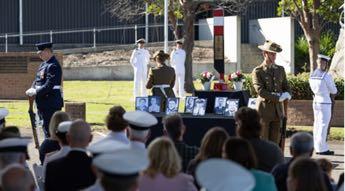

With ANZAC Day and Easter only a week apart this year, providing an opportunity for an extended break, our turn-out was slightly smaller than usual with apologies received from a number of our regular participating members. Nonetheless, we had 18-20 join us for the Main March here in Canberra with (always welcome) representation from current serving Canberra based Fleet Air Arm personnel. The Banner this year was carried by our Secretary George Sydney and, Assistant Secretary, Michael Sandberg.

Sadly, this year also saw the 20th anniversary of the crash of Sea King Shark 02, on the 2nd of April 2005, with concurrent services held at both Russell Offices here in Canberra and at the Fleet Air Arm Museum at Nowra. I thought it fitting to attend the commemorative service in Nowra – representing the

ACT Division.
The Nowra service was attended by the local Shoalhaven Mayor Patricia White, family members, a number of high ranking current and retired Flag Officers, along with a range of current and former serving members from all three services.
The Tail Rotor Blade pictured above, displayed as centrepiece of the commemoration and prepared by ARDU, is inscribed with the names our Navy and Air Force family who gave their lives in the service of their Nation. Their names are now also recorded in perpetuity on the Roll
of Honour at the Australian War Memorial.
We remember LEUT Matthew Davey; LEUT Jonathan King; LEUT Paul Kimlin; LEUT Matthew Goodall; PO Stephen Slattery; LS Scott Bennet; SQNLDR Paul McCarthy, FLTLT Lynne Rowbottom and SGT Wendy Jones
We Will Remember Them. Yours Aye, Bruce Tunnah OAM President ACT Division.
By Editor,
You can read a little about the lives of each of the victims of the tragic Sea King crash here.
By coincidence, I was in the Maritime Museum in Brisbane towards the end of May and was surprised to read about the interesting history of SQNLDR McCarthy’s epic rowing voyage from the Canary Islands to Barbados in 2001. It brought home to me the extraordinary lives that most Defence personnel lead, and their diverse and individual accomplishments that we often hear little or nothing about. ✈



G’day everyone. I hope this finds you all well and not impacted by the recent floods or drought. As I write this the sun is shining out of a blue sky and it’s a balmy 24 degrees. But before you all get too envious, the rain is scheduled to arrive tomorrow and continue for at least the next six days! Sadly, it might be time to pack away the boardies and the crop tops for a few months.
In one way our warm dry Autumn has meant we’ve been blessed with fine weather for our annual exodus down to Busselton for some serious R & R. We hire a bus to take us on a seven-hour trip to visit various wineries, breweries, distilleries and restaurants, as well as one opportunity for the ladies to shop. Our brilliant driver always manages to take us somewhere we haven’t tried before as the southwest wine region continues to expand, with distilleries being a fast-growing


by Sharron Spargo
industry. Our group of happy campers expanded to 16 this year, with all having booked their spot for 2026, when we will do it all again!
Continuing with the lunch theme, I’m pleased to report that 800 sausages were cooked and sold to the hungry patrons of HammerBarn in April, along with five copies of my book to customers who wanted to know more about the Fleet Air Arm. Ever spreading the word!

We also had our first casual lunch for members to catch up and socialise without our usual formal meeting. We had a great turn out and a great time was had by all. The photo (below) of Secretary Mick Spahn wearing what is, in my opinion, a very awesome shirt, was a hit with everyone. I offered him $5 which I thought generous for a used shirt, but sadly, all the attention went to his head and there was no sale. The design is

an old one apparently, but I’d love to know where I could find one, so if you have any idea, please let me know.
On Sunday May 4, the Battle of the Coral Sea was commemorated at the Rockingham Navy Club, with Greg Kelson and Brett Dowsing representing the Fleet Air Arm.
Below Left: President Mike Keogh and wife Lyn debating whether to buy a 6 litre, $1,400 bottle of Howard Park wine. It can be shipped to the east if there are any takers?
Below Centre: Secretary Mick Spahn with his awesome shirt. He was offered $5.00 for it but inexplicably, refused the sale.
Below right. Past President Greg Kelson, Ms Deb Hamblin (Mayor of Rockingham) and Brett Dowsing at the Battle of the Coral Sea commemoration.



Right. Battle of the Coral Sea memorial event: L-R Brett Dowsing; LTCDR Ryan Willis USN; Mayor Deb Hamblin, and RAN
Commanding Officer HMAS Stirling CAPT Ken Burleigh and Naval Association of Australia State President, Ian Holthouse. (Photo Greg Kelson)
The Battle of the Coral Sea, from the 4th to 8th May 1942, was a major naval battle between the Imperial Japanese Navy (UN) and naval and air forces of the United States and Australia. Taking place in the Pacific Theatre of World War II, the battle was the first naval action in which the opposing fleets neither sighted nor fired upon one another, attacking over the horizon from aircraft carriers instead. It was the first military battle between aircraft carriers.
President Mike Keogh attended the Stirling Gardens Battle of the Coral Sea memorial service, at the invitation of the North Perth branch of the Naval Association. Life Member and

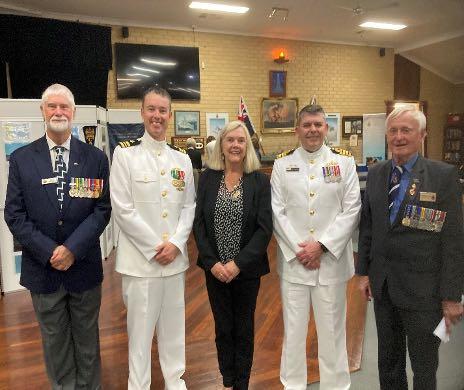
Past President, Jack LeCrais, who is 98 years old, announced that this was his last year organising this event.
Another ANZAC day has come and gone. The sun rose over a cool and quiet Kings Park but the march through the city was anything but. The impressive crowd was very vocal and appreciative of the veterans and those who are serving today. While the sun shone on our parade, one member, Ross Sarti, suffered a rather spectacular shoe blow out as our marchers had reached the last turn. Separated pieces of shoe were catapulted across the road and hit the curb.
Braking ranks, Ross dashed –(a bit of poetic license there. He actually hopped) across to retrieve his footwear, much to the amusement of the crowd. I’m pleased to say that he did re-join, and managed to finish the march, lop-sided, but unbowed.
Our members enjoyed a slightly quieter gathering at Jonny Fox’s this year, but the drinks were cold, the lunch was hot, and the camaraderie was lovely to behold. LEST WE FORGET.
Until next time, all the best from the west.
Sharron. Scribe. ✈
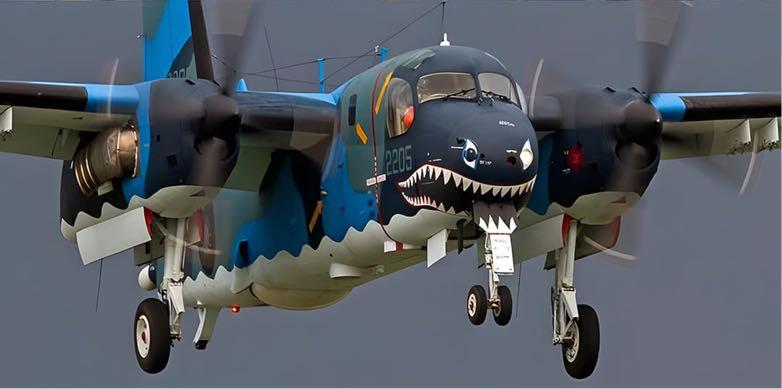

How’s this for a modern take on an old S2 ‘stoof’. New engines, new paint and, we dare say, new avionics and sensors and - bingo - you have a great anti-submarine/ surveillance platform for the next decade or so, by which time manned aircraft won’t be necessary. This is the Grumman S-2T Turbo Tracker of the Taiwanese Air Force. (Photo pinched from Facebook). ✈


Greetings to all members from the Victoria division.
by Mal Smith

Another ANZAC Day has come and gone and we were very lucky that the weather held fine for the march. The forecast was for heavy rain but fortunately it did not arrive until the afternoon. Our marching numbers were down slightly which I guess the forecast plus age of some members, myself included, it was to be expected. John Scott, a member of the W.A. division marched with us. It is always good to have interstate members joining where possible. I was unable to march this year and my thanks to Vice President Rob Gagnon for deputising.
Our Reunion / Lunch was well attended and our venue, the Mission to Seafarers, looked after us as usual. Once


again, our caterer made sure that no one went hungry. Great that several of our older members and their family’s managed to attend. I am indebted, once again, to Ken Pryor and David Hobbs for their usual sterling job in selling raffle tickets. Our raffle goes a long way toward covering our costs on the day. As the year has now rolled over to May, those members who have not renewed their 2025 subscription have now had their membership suspended. This action is always taken reluctantly and hopefully they will see their way clear to pay their subscription shortly, which is all they have to do to keep their membership active. We currently have eight members in this position and I am hopeful that when the don’t receive the June copy of
Slipstream it will jog their memories.
You will see in this June edition of Slipstream a great article by anonymous Victoria Division member Sailor Sam. I’m sure it will bring back many memories for those who served in the 50’s, 60’s and early 70’s.
Several weeks ago, I arranged for our President Chris Fealy and Vice President Rob Gagnon to come to the footy at the MCG as my guests. It was a great night (fortunately my team won) and they seemed to enjoy themselves. Chris hadn’t been to a game for many years and Rob being formerly a Canadian had only been once some years ago. I am hopeful that I have two converts to my team.
Yours Aye, Mal Smith. ✈
The Fleet Air Arm Association has recently taken delivery of a small(ish) stock of baseball caps for sale. Notable differences from the last stock are:
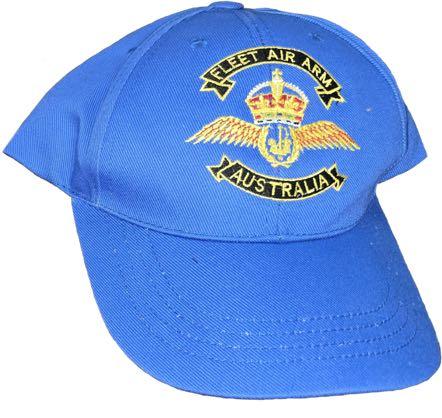

1.Lighter shade of blue for cap.
2.Larger wording and “WINGS”
3.”Kings” crown.
The new caps are priced at $20 plus postage (approx. $12).
How to order instructions are on the back page of this edition of Slipstream. ✈



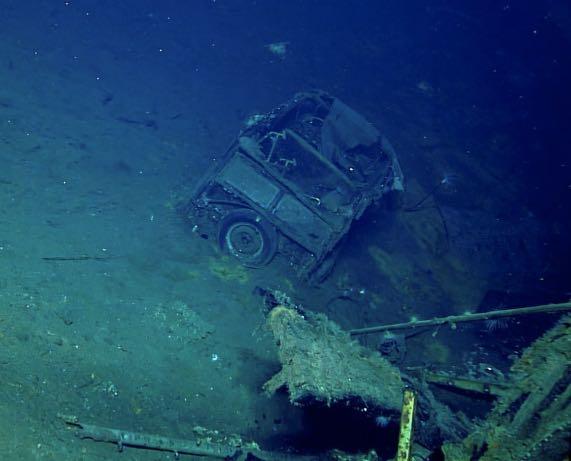
The USS Yorktown was sunk by Japanese forces in June 1942 with the loss of 141 men. She sank in 3,300 fathoms.
The wreck was found by oceanographer Dr Robert Ballard in May of 1998.
Now, a new survey is finding a few surprises, including a car suspected to be a 1941 Ford Super Deluxe Station Wagon, positioned in the ship’s hangar. Researchers believe the vehicle was used by RADM Frank Fletcher or CAPT Elliott Buckmaster for conducting business during ship’s visits.
The presence of the car is something of a mystery as most moveable equipment was jettisoned from the carrier as part of its damage control. It is not known why this vehicle was spared.
Even more surprising was the discovery of a virtually intact mural painted on the bulkhead of one of the ship’s elevator shafts. After 83 years of immersion the 42 x 12 foot painting was still vibrant, showing the world voyages the ship had undertaken during its time in service. It
NOAA researchers believe they found a 1940-41 Ford Super Deluxe Woody in the hangar deck of USS Yorktown. Visible in this image are rectangular rear windows, chrome detail on the fenders, a split windshield, parking lights above the headlights, and a chrome bumper (NOAA Ocean Exploration, 2025 Beyond the Blue).✈

was previously known of only by reputation due to lack of historical documentation.
Mirror images of the Yorktown are at the mural’s lower corners, but without any aircraft on its flight deck. A compass rose can also be seen at the bottom of the painting surrounded by seahorses, along with a border decorated by aircraft propellers.
Researchers believe the mural was painted by a member of the ship’s crew, although no signature was found. “We imagine the last people to have seen the mural would have been those who were abandoning ship at the time”one researcher noted. ✈
An underwater remote vehicle examines the 42 foot painting on an elevator bulkhead. After 83 years the colours were still bright and vibrant.✈
The Acting Secretary of NSW Division, Mr Ron Batchelor, wishes to advise new banking details for that Division. He says that people are still sending subscriptions not only to the wrong bank from eight years ago, and now they have changed again. New details are:
Bendigo Bank:
Name: FAAAA
BSB: 633 000
Account No: 229 352 307.

Boeing has recently hired a guy called Mark Fava whose job is to intersect between the leadership and technical elements of the company. This is traditionally a point of friction and, because of past failures in that space, is arguably why Boeing is in the situation it is. Fava served in the USN for 30 years, including a spell when he was aide to an Admiral. His simplest and most powerful leadership tip was this:
“Employees love great pay. They love great culture. They love great benefits...but this [tip] is free and easy. Just say, ‘Hey, thanks for a good day. Hey, how are you doing?’”.
It sounds obvious but it isn’t - and it works. Back when I was in Canberra I worked as the Principal Staff Officer for two different Admirals. One of them made a point of thanking me at the end of every day, no matter how miserable it had been. Guess which of the two I remember. ✈


Sunday 20th July 1947
by Graeme Lunn

Around Australia, in cemeteries from Nowra to Newcastle, Springvale to Sydney, are 1946 and 1947 burials of men from the Royal Navy’s 1st Aircraft Carrier Squadron. These are not war graves but graves of peace, the price of maintaining carrier aviation in Australian waters during the immediate post-war years as the country slowly reached consensus on establishing our own Fleet Air Arm.
Prime Minister and Minister for Defence John Curtin, worn down by the stress of wartime leadership and in terminal heart failure, was called on in mid-1945 by the Commander-in-Chief British Pacific Fleet, Admiral Sir Bruce Fraser RN, and the RAN’s Chief of Naval Staff, Admiral Sir Guy Royle RN. They wished to express their concerns for the RAN’s future once Japan was defeated, afterwards recording the Prime Minister’s declaration that the navy should be enlarged.
By the end of his appointment as Australia’s First Naval Member Royle had effectively lost the wartime carrier debate within Canberra’s Defence Committee and the Advisory War Council (see James Goldrick’s ‘Carriers For the Commonwealth’, right). Manpower and budget finally dictated that a carrier decision would have to wait until peacetime, despite the offer of the under
Read ‘Carriers for the Commonwealth’ on our website for the full background of the struggle to get organic air power into the RAN ✈



construction Collossus-class Venerable the previous year. Interestingly, as a Midshipman Royle served on the China Station during the Russo-Japanese War of 1904-1905 with fellow Midshipman Longmore, who became Australia’s first naval aviator in 1911. The now retired Air Chief Marshal Sir Arthur Longmore RAF had been briefly considered to head the wartime RAAF.
Acting-Admiral Sir Louis Hamilton RN relieved Royle as Chief of Naval Staff in late June 1945, a week before Curtin died. Hamilton, well briefed by the Admiralty, declared that he was “determined to revive the matter of two light fleet carriers” which he “was convinced the RAN needed”. The day before Hiroshima was bombed the Admiralty showed their undimmed desire to encourage an RAN carrier force when they cabled:
‘No doubt the Defence Committee in considering the nature, strength and organisation of post war defence forces will take into consideration the prominent part which aircraft carriers play in the modern balanced fleet, especially in the waters of the Pacific Ocean. (5 August 1945).’
The outline draft for a local air arm was completed by LieutenantCommander Victor Smith RAN that November. Joining an overly ambitious ‘shopping list’ the naval staff submitted a post-war plan to Sir Geoffrey Sheddon, the powerful and aloof Secretary of Defence, that included three light carriers, six cruisers, 32 destroyers and 50 escorts. Damned as unrealistic for a peacetime economy the Government Joint Planning Committee did at least agree the need for: “A balanced Task Force, including aircraft carriers”


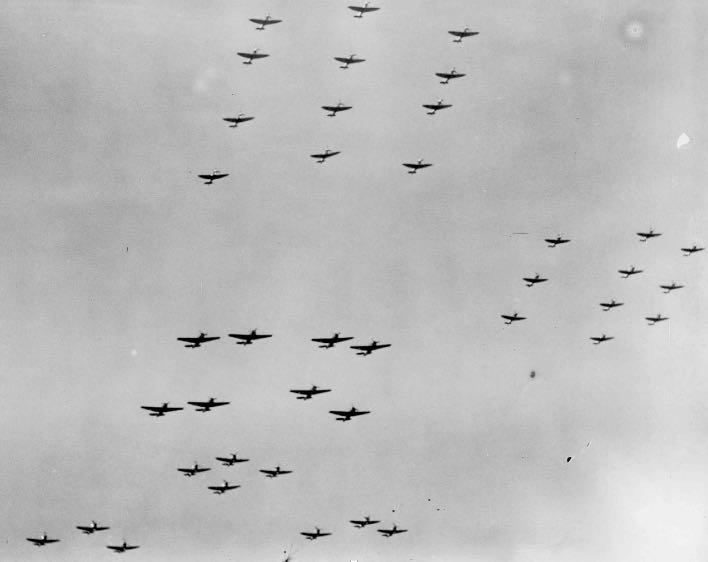
Top Left. Vice Admiral Sir Philip Vian Flag Officer Commanding 1st Carrier Squadron. Top Right: Lieutenant Commander Nigel ‘Buster’Hallett Air Group Commander. The drawings were done by Australian journalist and artist Kerwin Maegraith, who was embedded in the force for a few days. Lower: The massed 1st Aircraft Carrier Squadron flypast from Indefatigable Implacable and Glory with 72 Corsairs, Fireflies, Seafires and Avengers. The formation made three low passes over Melbourne city in a stunning demonstration of what Naval Air Power could look like. ✈
With the resumption of British control in Hong Kong and Malaya, as Commonwealth Occupation Forces started their duties in Japan, carriers of the 1st Aircraft Carrier Squadron, under Vice-Admiral Sir Philip Vian, did not just steam between Hong Kong, Singapore and Kure, they also frequented Australian waters for several years. Their presence enabled a subtle public and media campaign highlighting the value to the Commonwealth’s defence of a naval aviation branch. This ran concurrently with the confidential campaign for a carrier still being debated in the corridors of power.
On Tuesday 22 January 1946 the afternoon skies over Melbourne’s Navy Office at Victoria Barracks saw 72 Corsairs, Fireflies, Seafires and Avengers make three low-formation passes over the city. They were led by Lieutenant-Commander Nigel ‘Buster’ Hallett, a pre-war pilot who had fought from France to Tokyo. His observer, the then Lieutenant Victor Smith RAN, had saved Buster’s life when their Fulmar fighter was shot down over the Mediterranean in 1941.
These aircraft had launched from Indefatigable (Flag), Implacable and Glory off Wilson’s Promontory. All three carriers had spent the previous months, their air groups disembarked to New South Wales air stations, repatriating troops and liberated prisoners of war. With squadrons reembarked in January 1946 their combined 80,000 tons were crewed by 6,000 men, making this the
largest naval visit to Melbourne since the 1930s. As they secured alongside Station Pier a funeral party mustered and went ashore, a pilot having died the previous day as the formation aircraft were recovered.
Sub-Lieutenant (A) Peter ‘Sandy’ Sanderson RNVR (21) had made a pass at Glory’s deck out of turn and was waved off. Firefly MB518 was obviously suffering from a coolant leak, white smoke pouring from the engine, as he turned steeply over the flight deck before ditching. Although his observer was uninjured Sandy, despite three hours of artificial respiration by the determined Surgeon-Lieutenant of the rescue destroyer Tuscan, failed to respond. He was buried with full military honours, led by Vian with six squadron pall bearers, in the War section of Victoria’s National Cemetery at Springvale.
Participating in that fly past over Melbourne was Implacable’s No.801 (Seafire XV) Squadron with its many Australian RANVR aviators (see ‘The Two Dozen’ in Flyby April 2023, below right). It was only six months since the first of this group, air force volunteers to don navy blue and fly with the British Pacific Fleet, had deck qualified onboard Indomitable. The original twenty-four had already been reduced to eighteen through death, injury and discharge to shore. They had accepted continued RN service on the proviso of a return to the RAN if subsequently required for flying duties.
Embedded in the force for several days was Australian journalist and artist Kerwin Maegraith. He had earned his guest billet onboard the flagship by writing the lyrics for the Australian composed march ‘British Pacific Fleet’, now to be played on all ceremonial occasions. Kerwin sketched everyone from Flag Officer to boy Bugler, including six of the RANVR pilots. These young aviators were good copy and lauded in the local media as bronzed and fit ‘Australians who have joined the RANVR after meritorious service with the RAAF’.
For eight days Melbourne was in thrall to the visiting carriers. Malvern Town Hall hosted the Ratings Dance where each man was given a tin of fruit to take back to still rationed families in Britain. Vian, in addition to his official calls on the Governor and Lord Mayor hosted, in Implacable’s hangar, 500 guests that included the First and Second Naval Members, Chief of the Air Staff Air Vice Marshal George Jones (a staunch advocate for his service who had been a private at Gallipoli), the Governor-General, Chief Justice and the acting Minister for the Navy. One thousand men marched with massed bands through the city watched by 250,000 Melbournians and 100,000 queued for hours to visit the ships.


Above: Implacable, Indefatigable and Glory visit Melbourne city in 1946. The size difference between at 32,600 ton carrier and an 18,000 ton light carrier is marked. : Thousands of Australians queued to see the British carriers. Below. Read “The Two Dozen” from page 34 of April 23’s ‘FlyBy’magazine.
Only five months after the end of World War Two, the powerful physical presence of carriers and crew demonstrated clearly to the locals that naval air power was ‘vital to a country like Australia’. It was immediately reflected in newspaper columns under such headlines as ‘Our Safety Demands SeaBased Planes’:



“The visit … reminds us that, despite the lessons of the Pacific war, the RAN faces a future entirely lacking sea-based air power and the means to train a Fleet Air Arm”. (The Herald, 23 January 1946 p4.)
Buster Hallett was interviewed. After noting that only two others of the twelve in his 1935 Pilots Course were still alive he stated: “If Australia is to have a post war navy I should imagine she will have a couple of aircraft carriers” (The Age, 24 January 1946). Vian, a man who had
commanded the Eastern Task Force at Normandy before leading Task Force 77 carriers against Japan, was uncharacteristically coy when he declined to discuss the lessons to be drawn from the application of combined sea-air power in Pacific warfare merely stating that: “they were now obvious to everybody” (Argus 31 January 1946)
Undoubtably Admiral Hamilton would have been pleased at this reporting and immediately moved into emollient mode within the Department of Defence. In February he wrote that: “I have made a start with Sheddon and I hope that I may be able to work him round into an ally. My method of approach is quite simple - simply to feed out of his hand! If by so doing, we may get the requisite Naval Air branch, all is well”.

In early March a brief visit was made to Melbourne by Implacable and Venerable. Although an ‘unofficial visit’ for crew rest some 50,000 visitors still looked over the ships on their open days and Vian dined-in the Governor and Lady Dugan. Sailing for a planned refit in Sydney Sub-Lieutenant (P) Neville ‘Junior’ Faulks RANVR (22) was disembarking ashore when his Seafire stalled and ditched off the bows of Implacable. His body was not recovered.
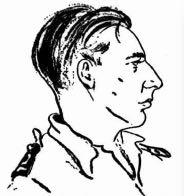


Above. (Clockwise from top left): Some of the Air Group Aussies. ‘Spanky’ Brown (Dromana); Keith Clarkson (Essendon); Bob Davies (Adelaide); ‘Junior’ Faulks (Cootamundra); Brian Smith (Adelaide) and ‘Bunny’Hare (Wahroonga). Four of the six were to lose their lives to naval aviation. ✈
chiefs and other VIPs, plus a group of CadetMidshipmen from the Naval College at Flinders.
In April 1946 the Naval Board gained approval to initiate aviation planning with London’s Admiralty provided no financial commitments were made.As RAN plans matured, and air force opposition continued, it was decided to demonstrate the usefulness of carriers in a ‘Shopwindow’ sea-day for VIP’s in June aboard Glory.
After leaving Melbourne with the other carriers at the end of January Glory had exercised off Sydney before ordered to New Zealand. On passage she dumped her lend-lease Corsair fighters into the Tasman Sea via catapult. It was ironic that on arrival in Auckland twenty-four Corsairs of No.14 Squadron RNZAF were immediately loaded for transport to Kure, where they joined the Occupation Forces. On return to Australian waters there was persistent scuttlebutt that Glory was to be transferred to the RAN - or the French!
Vice-Admiral Vian had handed over to RearAdmiral Charles Woodhouse, captain of Ajax at the Battle of the River Plate against the Graf Spee, who now flew his flag in Glory. Since burying SubLieutenant Sanderson Glory had suffered five further fatalities in crashes, ditchings and flight deck accidents. Setting course from Sydney for Adelaide, rehearsals were flown for the planned day of strikes, interception exercises and live firings to impress their guests. On Monday 24 June, off Westernport Bay, the carrier received onboard four federal Ministers, all three service
The visitors enjoyed the rocket firing and dummy attacks on the ship but saw a Firefly snap its hook after catching a wire, losing its wheels entering the first barrier at speed until finally stopped by the second barrier. Goofers afterwards argued over who beat who out of the wreckage, pilot or observer. The second crash was famously filmed, Firefly DK481 hitting the round-down and the cameraman steadfastly holding his position with the slewing aircraft stopping just over a metre from him (Australian War Memorial online Film F03463). That pilot also emerged unhurt from the wreckage, although a Cadet Midshipman was treated in the Sick Bay for a head injury from a flying piece of propeller. As the guests departed some were keen for Australia to have its own carrier but others, including Air Vice Marshal Jones, were not. The Melbourne Age wondered if the sea day would help prompt a decision under the headline ‘Will R.A.N. Get A Carrier?’
To encourage that decision the Admiralty in September offered the biggest BOGOF - Buy One Get One Free - deal in Australian history. Britain had ten light fleet carriers in various stages of construction in 1946, well in excess of their own navy’s peacetime needs. With each hull costed at £2,750,000 the RAN was offered two carriers for the price of just one. Throwing in two outfits of armament and stores to sweeten the deal a total bargain sale price of £3,650.000 was mooted.
By May 1947 Admiral Hamilton's nuanced campaign within defence, bolstered by the bargain BOGOF, had won over Sheddon. Since Sheddon
had the ear of Prime Minister Ben Chifley his concurrence saw Chifley provisionally approve the acquisition of two carriers.
Taking the decision with bad grace Air Vice Marshal Jones continued agitating for his own service to man the new air branch. On 16 July 1947 Chifley decided in favour of an RAN manned Fleet Air Arm - the branch would be naval in uniform, naval controlled and use naval stations and facilities. This carrier decision was the fundamental basis of the new five-year Defence Plan, which necessarily saw the navy win the largest budget of the three services. After being agreed at the Commonwealth Defence Council the Defence Plan was announced in Parliament by the Minister for Defence, the Honourable John Redman, on 4 June 1947.
Keen to demonstrate the capability that this Australian carrier decision would lead to in several years' time, it was decided that when Glory and Theseus visited Melbourne in July they would put on a show for senior service personnel and other VIPs. In the twelve months since Glory’s last Shopwindow off Westernport she had added another six fatalities to her Roll of Honour. Poor weather during the voyage down from Singapore meant there had been only two flying days for the embarked squadrons before a fly past and demonstrations over Adelaide as they passed into Bass Strait.
visibly impressed with the intricate flight deck operations and another demonstration was planned for the following weekend.
Overall, the nine-day visit was summed up as “boozy, romantic and practically sleepless”. It culminated with the official farewell party on Saturday evening which extended well into the morning hours of Sunday 20 July 1947, a day scheduled for a 10:00 departure with a major shopwindow of carrier operations in front of visiting dignitaries. In retrospect, the scheduling of intensive flying immediately after intensive socialising was not the wisest decision. Glory first flew off Seafires from her large range aft allowing space for more visitors onto the flight deck.
❛ In retrospect, the scheduling of intensive flying immediately after intensive socialising was not the wisest decision ❜
As they watched Theseus's aircraft forming up at 14:00 for a farewell fly past over the city, two aircraft of No. 812 (Firefly) Squadron collided, spiralling into Port Phillip Bay locked together. Both crews, LieutenantCommander (P) Nathaniel Hearle RN (32) with Lieutenant (A) Kenneth Sellers RN (24) and Lieutenant (P) Raymond Walker (24) with CPO (A) William Lovatt (26), were killed. Undeterred, Theseus's Air Group Commander then flew a spectacular aerobatic display for the visitors.
On the first Tuesday of their nine-day visit, the two carriers left Station Pier with all three members of the Naval Board, along with senior officers from the other services as well as a state minister and the mayor. All admired the professional recovery of the disembarked aircraft from RAAF Point Cook and watched the displays of bombing, rocketry and cannon firing at towed targets. Theseus's Captain Robert Dickson RN, who as a midshipman had landed Anzacs under fire at Gallipoli, had his private Tiger Moth named Montague onboard. After a sixteen aircraft “T” formation was flown, and following a spectacular Seafire rocket assisted take-off, even Montague got airborne in a free takeoff flown by Commander Robert Everett RN (see WTF? Flyby Nov 2024 p23, left). The RAAF officers, despite declaring it all ‘a bit dicey’, were
Only the body of Hearle, 812’s Senior Pilot was recovered by destroyer for burial at sea the following day. Nat Hearle, disembarked from Glorious in 1940 and operating under the RAF’s Coastal Command, had flown minelaying and bombing operations along the coasts of Holland, Belgium and France until his Fairey Swordfish L2819 was shot down in August. He and his observer spent the rest of the war as prisoners.
Thirty minutes later, as the shaken squadrons landed back on Theseus, a Seafire caught the wire off centre and slewed, narrowly missing the batsman but its arrestor hook hit Ordinary Seaman Anthony Timmons (19) on the flight deck walkway, killing him instantly. When Glory's Seafires returned No.806’s squadron commander came in too fast, bounced over the barrier and crashed into the forward aircraft park. Two air mechanics were injured, with the most serious rushed ashore in the destroyer Contest. Air Mechanic Terence Sadler (19) was declared dead on arrival at the Heidelberg Repatriation Hospital and buried in Cerberus’s Crib Point cemetery.


To the eyes of the Second Naval Member, the Secretary to the Department of the Navy and the various senior RAAF officers and assembled press, Glory’s flight deck scattered with seven
Main: A Fairey Firefly operating from HMS Theseus in 1947. Inset: Lt.Cdr Nathaniel Martin Hearle and Ordinary Seaman Anthony Eli Augustus Timons were buried at sea the day after they were killed. Below: The plaque taken to the wrecks of the two Fireflies exactly 60 years after the mid-air collision that claimed four of the six lives lost on 20 July 1947.✈

wrecked aircraft most resembled the aftermath of a determined kamikaze attack.
Attempting to popularise the concept of Australian naval aviation in front of senior service and civilian guests the ‘Battle of Port Phillip’ had cost Theseus two Fireflies, while Glory wrote off a Firefly and three Seafires with three Fireflies badly damaged. If the day had demonstrated the capability of a carrier the loss of six lives had shown the considerable costs that capability incurred.
Postscript:
Two weeks later on 5 August 1947 Glory and Theseus sailed in company from Sydney, heading home at the end of their first commissions. Flying stations the next day saw Theseus lose four Fireflies in four minutes, one even hitting the bridge before cartwheeling into the water, while another hurdled the barrier sweeping a second aircraft into the sea with it. Air Mechanic Glyn Daly (19) was killed on the flight deck but, amazingly, all the aircrew survived with only one injured. Glory also wrote off a Firefly in the barrier and Rear-Admiral Woodhouse decreed no further flying until after an intensive training period ashore.
Buster Hallett DSC*, who had married a local girl he’d met when his carrier visited Adelaide, returned to Australia on loan service, instructing for several years at RAAF Laverton’s Air Support School. He’d had an interesting career, having been grounded after pilot’s course for buzzing his girlfriend’s house,
and then dismissed the Service for disobeying an order. Reactivated at the start of the war he became one of the Navy’s leading aces flying from Furious, Ark Royal and Victorious. As a fighter wing leader he led four squadrons over the Normandy invasion beaches and, as the Air Group Commander of Indefatigable, led five squadrons over Japan in 1945. He finished his career as Captain of the Royal Naval College Greenwich, and after a life fully lived died in 1993 aged 80.
Divers discovered the wrecks of Theseus’s two Fireflies in 2004, still with human remains. A memorial service was held over the site at 14:05 on 20 July 2007, the 60th Anniversary to the minute of that tragic collision. After the ceremony divers placed a memorial plaque on the wrecks.✈

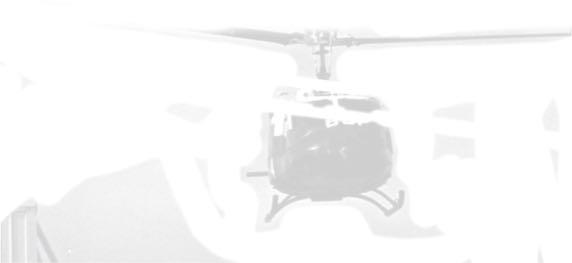



Sometimes, fate is kind. Sometimes not.
by Roger Harrison

The date was the 5th of June 1968, and I was serving on 723 Squadron at the time of the accident, and it was always my aim to grab a ride (to act as ballast for a better Centre of Gravity) with any of the aircraft and friendly pilots completing airborne exercises in and around the Naval Air Station at Nowra, NSW.
On this particular morning, I was late getting to the Squadron for whatever reason and was beaten to the spare seat by Naval Airman Ross Smith. The Iroquois N9-881 lifted off around 0800 bound for Beecroft Range, where it would drop off LEUT Robert Ray who was to organise a rifle shoot later that morning.
It was stated that the helicopter took off and made another circuit of the firing range and as it crossed over the Crocodile Head area, it appeared to lose control and rolled over, hitting the cliff face where it exploded and fell 300 feet into the sea below.
LEUT Ray ran to the Point Perpendicular lighthouse to raise the alarm. The Air Watch control tower crew spotted the smoke and attempted to contact the helicopter without success. Two Wessex helicopters were scrambled to search the area and eventually found the wreckage at the bottom of the cliff face in 60 feet of water. A strong gusty wind was blowing at the time which made the search and rescue just that more dangerous. Wind shear?
killed were the pilot
From memory, 723 Squadron went into shock when the news reached us. The A700 was collected as were statements from witnesses to the morning take off. I am guessing Ross Smith completed the BFI on the aircraft and all of the Squadron Naval Airman fell silent as they mentally went through the walk around BFI for the Bell UH-B helicopter, including me.
It had not yet dawned on me that I could have been on that casualty list.
Roger Harrison ✈




Paul Greenfield and David Prests acclaimed book “The Skyhawk Years” was a collection of memories and yarns from folk who maintained and/or flew the RAN’s A4. Copies are still available here. Some of the material submitted didn’t make it to the finished product due to size restrictions, so we are pleased to bring three of these previously unpublished stories to you in this article.
I joined the Navy in February 1969 and after initial training at HMAS Cerberus, I left for HMAS Albatross in May 1969 as an Ordinary Seaman (Ord EMAC) and started off my aviation career as a Bosuns Mate on the main Gate amongst other “important” tasks. A short time later, I and a number of Ordinary Seaman birdies were posted to HMAS Melbourne which was in Cockatoo Island dry dock, having a new bow installed, following her collision with USS Frank E Evans.
My time on the Melbourne was a little unpleasant as we had to go off the ship and into the dockyard for ablutions but as some compensation; we were working short routines with plenty of time off. During this time, the dockyard workers were on rolling strikes and the ship was on the dockyard workers “black list”. At the end of the repairs and as the ship was “black listed”, the Melbourne moved itself out of the Cockatoo Dock and back to Garden Island where post repair trials were performed including using “Chloe” to test out the catapult.
As an OD on Melbourne, I was initially on the forecastle part of ship and watching the anchor letting go was most interesting. I was also “lucky” enough to be on the team to paint the Melbourne’s Port side, to have the never ending relentless demeaning task of scrubbing 4K Flat, a high traffic area, and to be sent out to get some fuses for the deadlights. My supervisor had his horoscope read for that.
The best part of my time on the Melbourne as an OD was being in the ships laundry. Although hot and steamy it was a good environment with a good Leading Hand in charge who personally ironed all the skippers gear. We mostly did ironing/pressing using the large steam presses, hence the heat and steam and we worked in shorts and sandals only. I still have some small burn scars from the steam presses from that tasking! The laundry staff did get some perks, food, etc and I managed, on a couple of weekends, to sail on Sydney Harbour in the Melbourne’s Bosun Dinghy, a rare treat for a young Tasmanian.

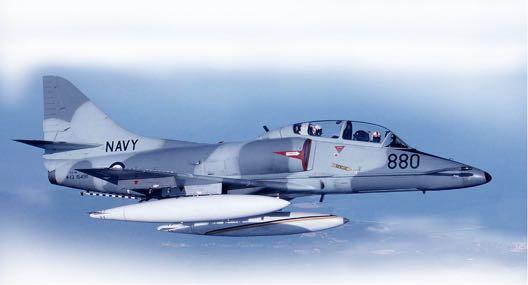
While still on the Melbourne, two unpleasant things happened to me. The first happened while chipping paint on the flight deck. I received some welding burns to my eyes from the arc from a welder who was working some distance from me. When I awoke later that night I was partially blinded and had to be helped to the sick bay by another birdie OD where the Duty SBA was able to provide relief with some eye drops. The second unpleasant thing was being charged which was my first and only charge, in 25 odd years of service. I was part of the duty watch and at 0700 muster on the quarterdeck; I arrived as the pipe was made, not before! At the subsequent offenders table and being an OD and it being my first charge, I was clueless as to what was happening. To make things worse, I ended up standing next to a noisy exhaust fan and couldn’t hear anything but was found guilty and was awarded 3 days Number 9’s punishment, not knowing what had just happened and why!
On the long weekend in October, and armed with a couple of extra days leave, a mate and I decided to hitchhike to Melbourne from Sydney, from where I would fly home to Wynyard in Tasmania. We managed to get a lift as far as the Canberra turnoff, but we were in 2A’s and it was very cold. After some time a truck stopped, not for us but to check his load so we asked nicely for a lift and thankfully, he took pity on us and off we went. There was only one spare seat so we took turns and sat on the engine hump/cover during what were many uncomfortable hours all the way to Melbourne. However, I had missed my plane but managed to get a later flight. With the passing of time, I cannot remember how we got back to Sydney, but we did not hitch, or fly, as you can imagine we were pretty poor back then! However, my OD time on the Melbourne was an interesting eye opener to the Navy but sadly we were posted off at Xmas 69, (leave and draft) back to Albatross for course, missing out on the trip to Expo 70 in Japan!!
I undertook my first A4 course in January 1970 and onto VC 724 in May 1970. Tony Innis. ✈
The Skyhawk squadron, VC724, was an interesting organisation to be a part of in the early ‘70s. It was full of characters that were missing when I came back to the squadron in the early ‘80s.
There were some interesting characters and one was an unnamed Naval Airman (NA) who was fond of a drink or three as were a number on the squadron. Different days then. My first detachment was to RAAF Base Williamtown (1971) and the NA was one of the support crew. It was the days of the last of the RAAF Sabres as they were progressively handed over to the Indonesians. It was also when the Army parachute school was at Williamtown. Where is this going you may well ask?
Well, it seems the NA and his fondness for drink managed to get himself in the same bar, the RAAF boozer, as some of those strange Army chaps who like to jump out of serviceable aircraft. The next day still in a alcoholic haze, he fronts up to the flight line hut looking like he had been in a cat fight i.e. scratches all over him. It seems that the previous night he had “won” his parachute wings (half a dozen jumps? from a serviceable aircraft) the night before. “But you didn’t jump from an aircraft” we chorused. “No” he said, “It was from the second storey of an accommodation block”. “And where did all the blood and scratches come from?” we said. “Well,” he said” I kept landing in the rose bushes in the garden below the jump window”. David Prest. ✈


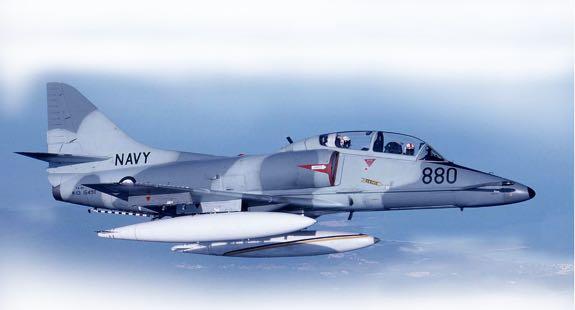

Embarking 805 Squadron, the front-line squadron, on 9 April 1969 for our first RAN Skyhawk cruise, the Melbourne headed North. One night, during an Exercise Sea Spirit, a Surface Attack Group (SAG) was scheduled to approach and attack the fleet. Trackers searched diligently and one made a brief sighting report before going radio silent except for an air-to-air TACAN. That TACAN was tuned to a pre-briefed frequency indicating which of the four cardinal points the Tracker might orbit at 500 feet, exactly 10 miles from the shadowed target.
The Skyhawks launched, also radio silent except for one intermittent TACAN, and made a low-level transit in the pitch-black night to pass under the Tracker at best speed. At the right moment the leader pulled away, turned 10° left, climbed and held speed at the flare drop limiting speed while Number Three and the other two
aircraft turned 10° right and climbed for a simulated rocket attack. The six-flare drop illuminated the SAG perfectly, two destroyers nestling closely to a cargo ship. The rocketeers did the rest.
Re-forming, everybody flew home to Mother, highly satisfied with a novel job well done.
That was the night, when despite official and unofficial briefing after briefing and increasing the “no-go zone” from two to three miles ahead of the carrier, lighting up the darkened carrier with every possible light, automatically stopping the exercise, sounding the siren, sending warnings and even altering away from a probable whistle down our starboard side, USS Frank E Evans closed, fine on our starboard bow, then made a sudden dart to starboard, directly across our bows.
Lumbering along at close to 25 knots, there is not much any aircraft carrier could do to evade the collision. Had Evans initiated that same turn just five seconds earlier she might have frightened the life out of a few Melbourne compass platform watch keepers but just avoid contact. Five seconds later, she would probably have rammed us amidships and sunk us both. Ten seconds later she would have maybe passed just clear astern.
The follow up formal inquiry was a farce, with little or no attention given to Evans’s captain lying abed and not on his bridge as demanded by exercise orders; neither of the two deck officers on Evans’s bridge had any formal night watch keeping qualification; no identification was made of who ordered nor why that fatal turn starboard order was given and, after putting their ship into a dangerous situation (inside the carrier’s three miles exclusion zone) why they failed to heed Melbourne’s both en-clair and simple code warnings.
Fred Lane. ✈
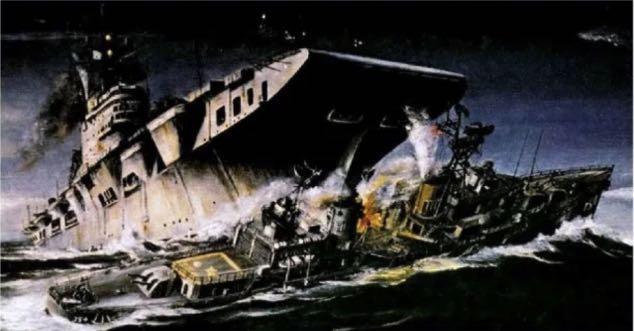
Since the March 2025 edition of Slipstream we have learned of the loss of the following veterans.
Martin Victor


Surgeon Leut, Martin Samuel, later an ophthalmic surgeon, died 29 Dec 1998 age 53.
Read more here

Lance (Larry)

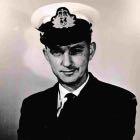
Larry, ex LCDR GLEX(E) passed away on Anzac Day 2025 at the age of 86 from dementia.
More here
Tom
Tom died on 18 May 2025, aged 93.
More here
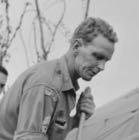

Ronald

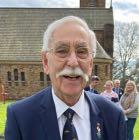
Ron Christie, OAM, passed away at the end of May 2025. He had been a staunch supporter of the FAAAA for over 40 years. More here

Robert


The RSL has advised the death of Bob Brennan early in 2025.
More here
Bob


Bob Scopie R37071 passed away on 12 May 2025 after a long illness, aged 94.
More here.
Bernie
Bernard (Bernie) died in May 2025, aged 96.
More here


Fred Ian

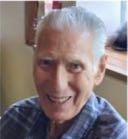
Fred Rubly passed away on 20 March 2025 after a long battle with leukaemia.
More here

Brian


LSCK Brian Bowes passed away on 12 April after a short illness. He had served in the RANHFV.
More here.

Maurice
Maurie Tiffen passed away in Canberra on 31st May, age 95. He was best known for his role as SATCO in 1978.
More here

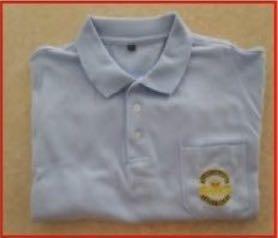






New FAA cap design with King’s crown. $20.00 plus postage


For all items contact Jock Caldwell via email on flynavy@shoal.net.au, or phone/text 0411 755 397. Let him know your request and he will get back to you with pricing and payment details. Payment can be either EFT, direct deposit or cheque.
Expect postage of $10-15 per order.✈
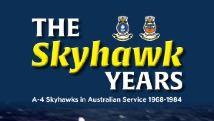



The Skyhawk Years is a story of the RAN’s iconic “Scooter” A4s from when we first acquired them, to their demise at the hands of the Hawke government. With first-hand stories from pilots and maintainers, the challenges of operations from the world's smallest aircraft carrier are well explained. Also told are thrilling stories of air combat manoeuvres against fighters from other countries, with the A-4 often surprising more wellcredentialled adversaries. Buy it here. ✈
This meticulous and beautifully written book on the life of Admiral Sir Victor "VAT" Smith RAN is a fitting tribute to his extraordinary life. VAT was just 13 when he joined the Royal Australian Navy in 1927, where he specialised in aviation. He rose to the rank of CDF and was our first four-star aviator. Buy it here ✈




Outofprint.Ifyouareinterestedinbuyinga reprintpleaseemailhere.Thiswillgivethe publisheranindicationofnumbersrequired.
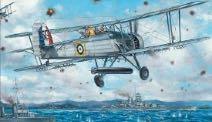
The history of HMAS Melbourne is about to be published. This 202page book from the Naval Historical Society of Australia will be in soft cover, A4 landscape format. It includes more than 400 photographs and other illustrations. Expect to read stories of her deployments and missions, her aircraft and equipment, and the crews who operated this versatile naval asset. It describes the origin of the light fleet carrier, the changes made for her entry into service, and the updates given to the vessel over her life. ✈
